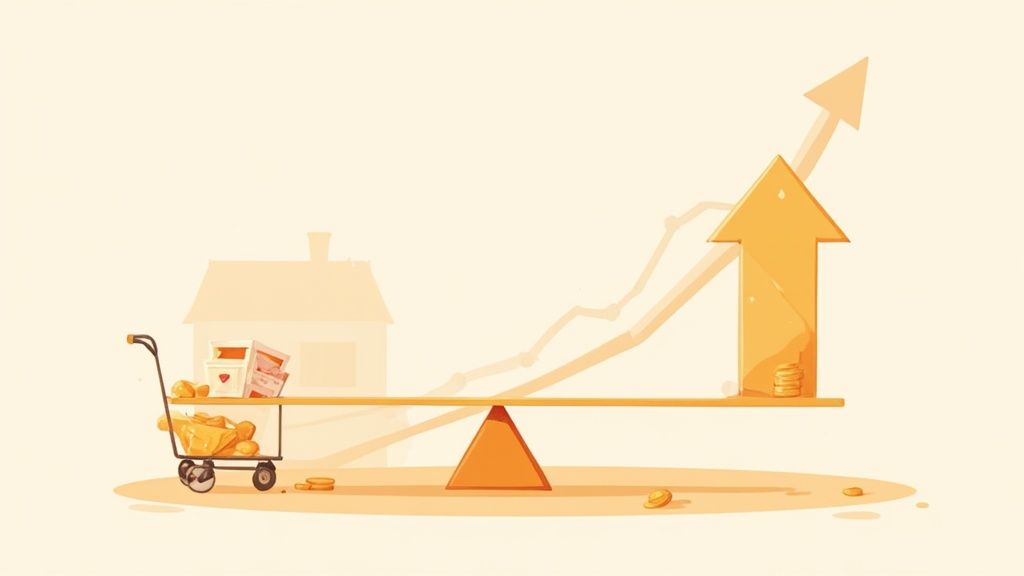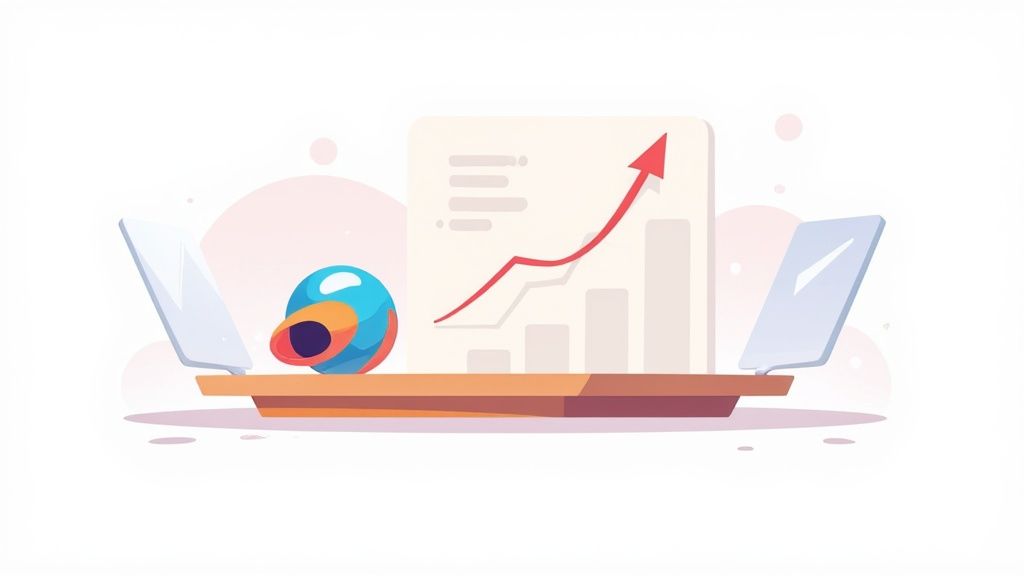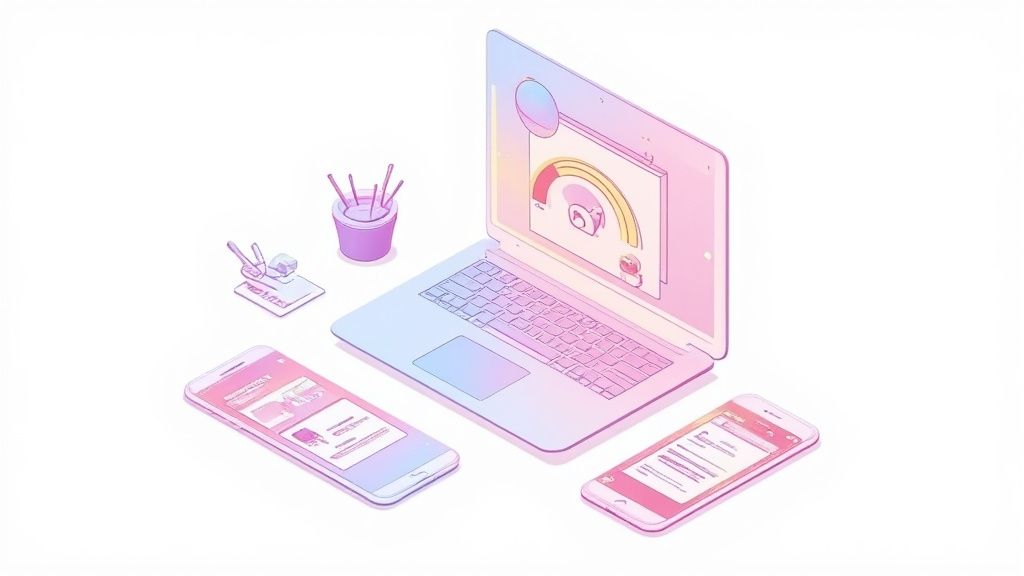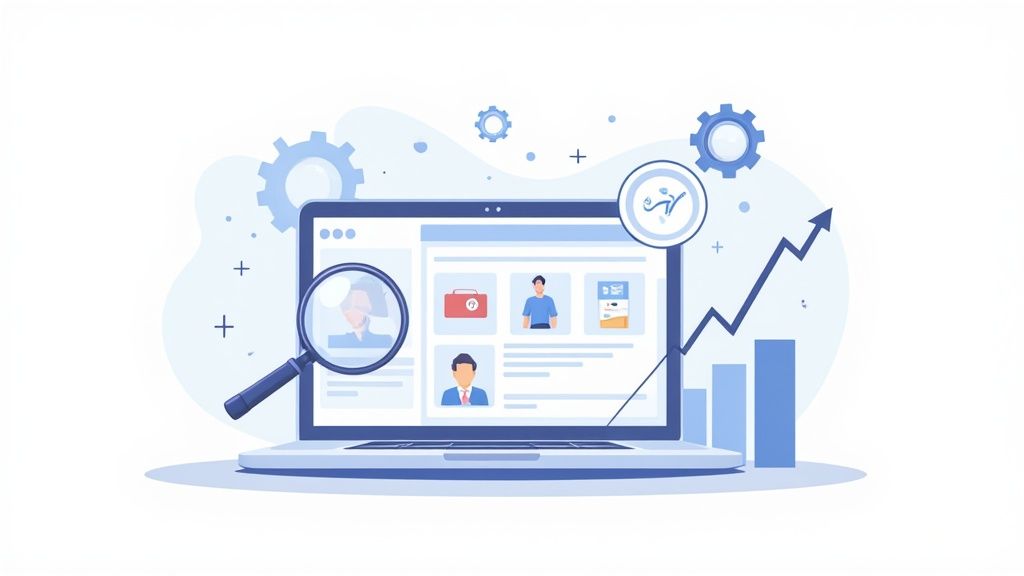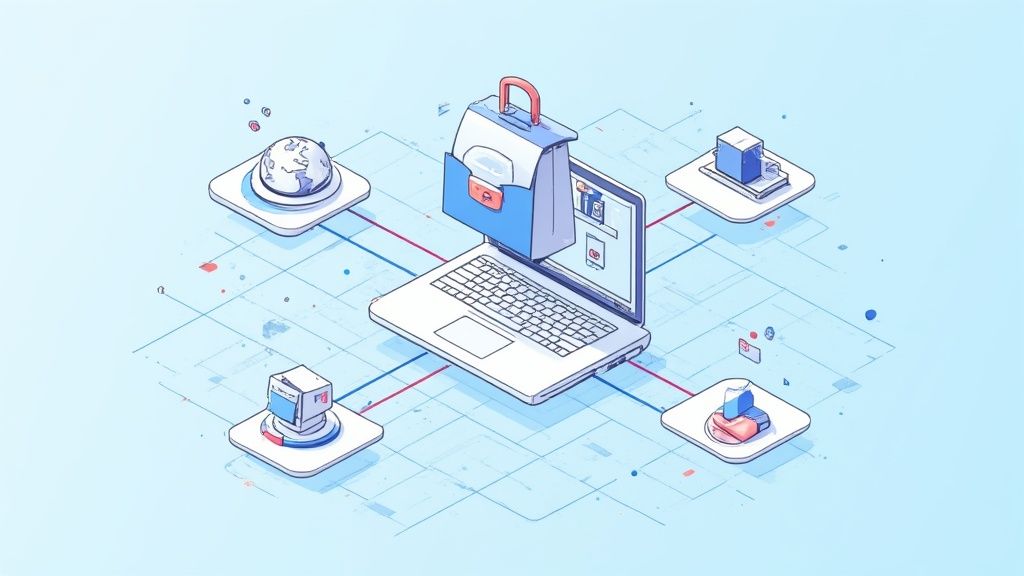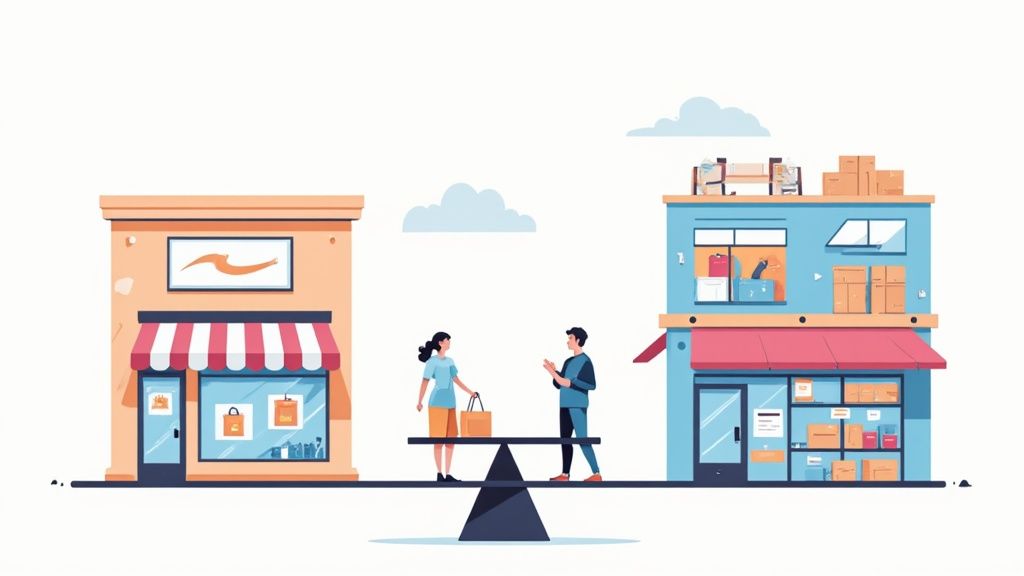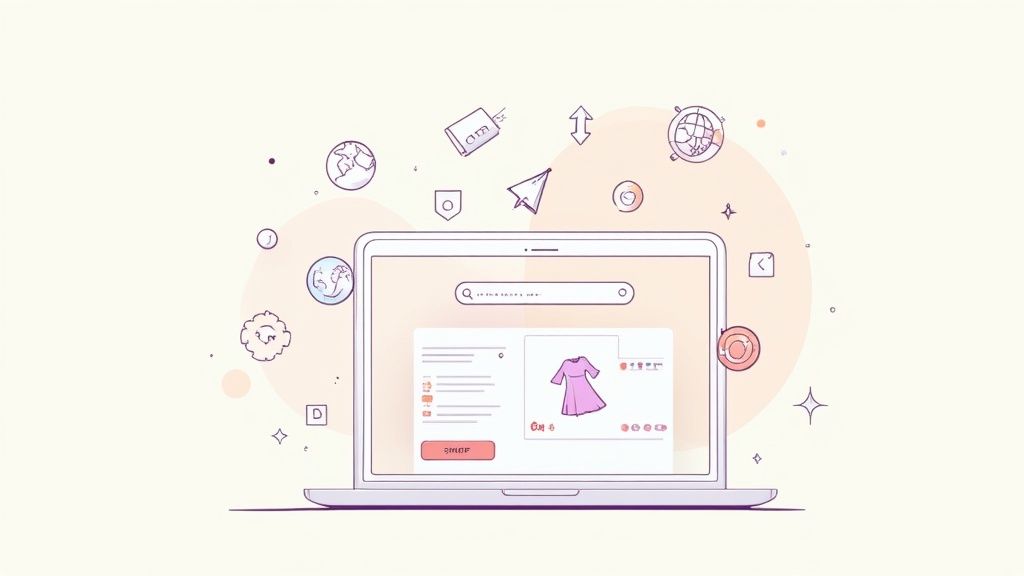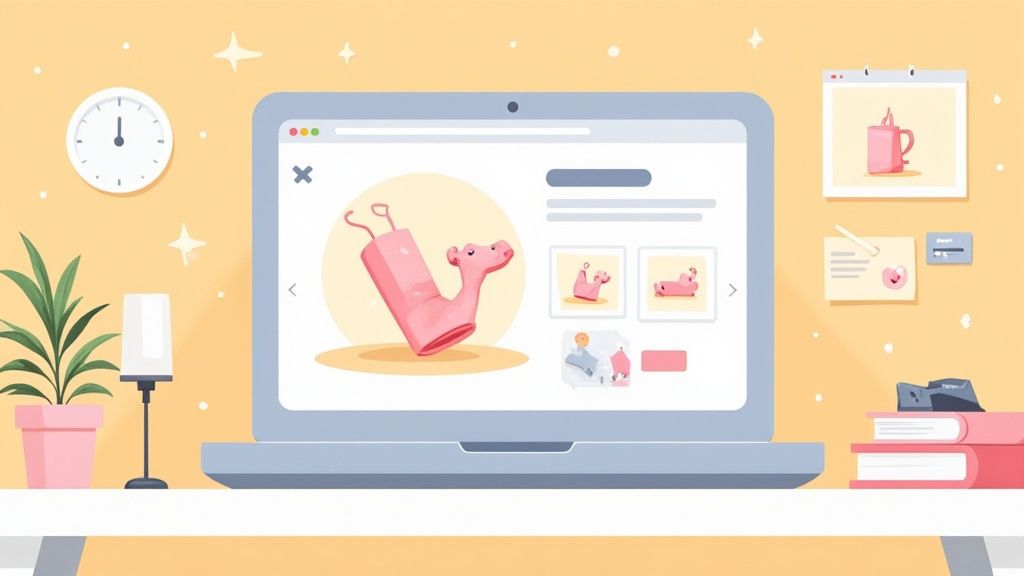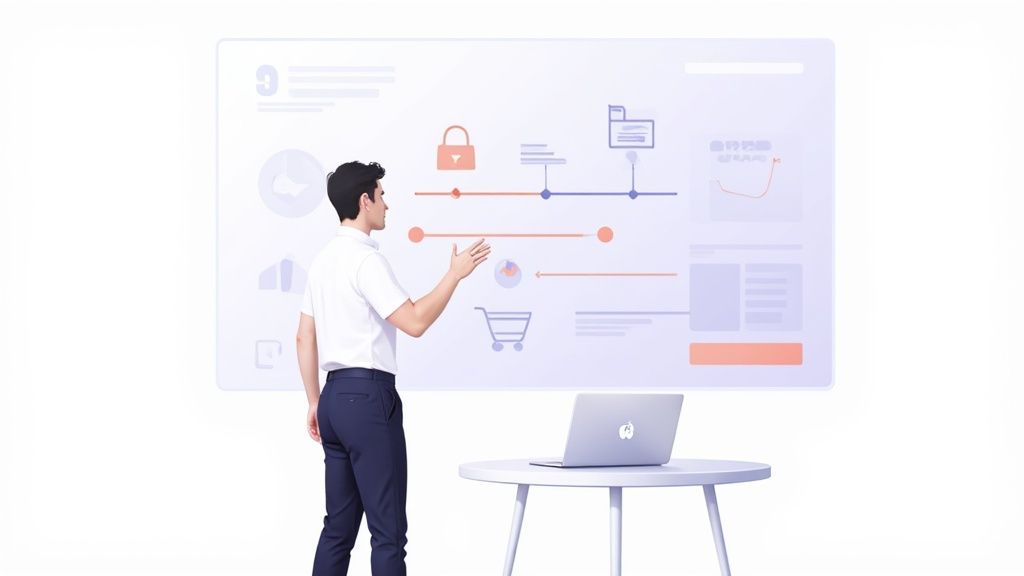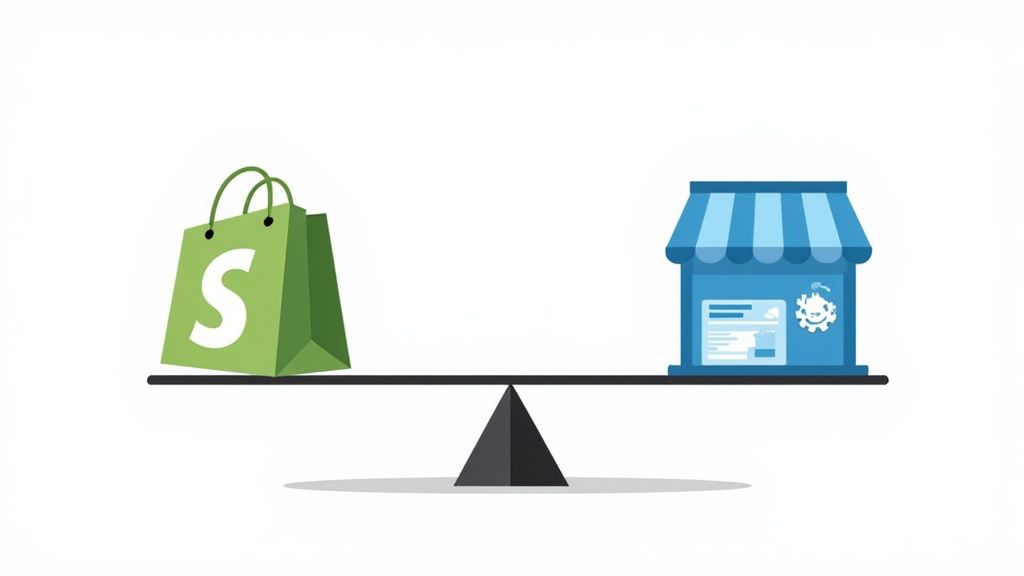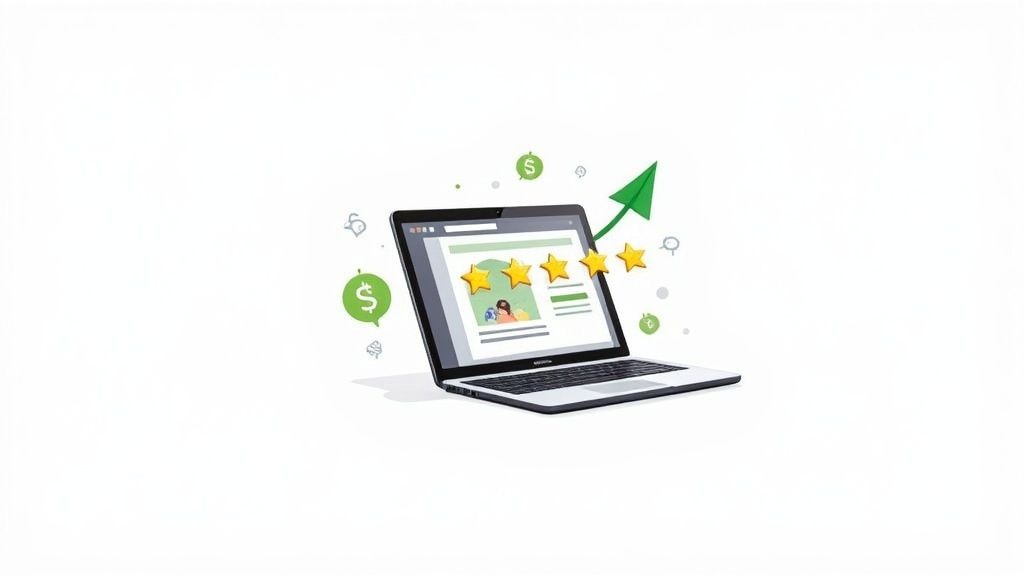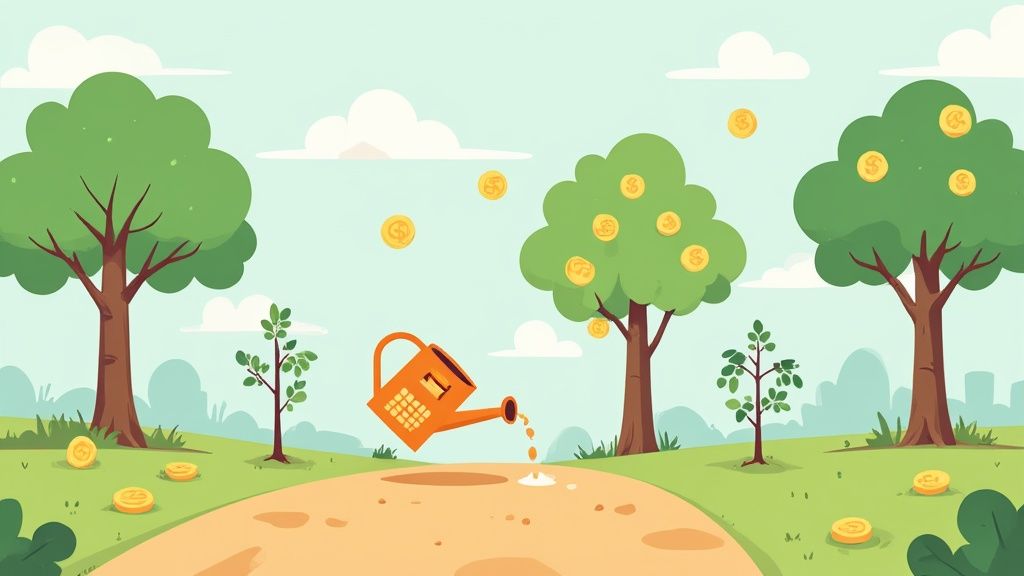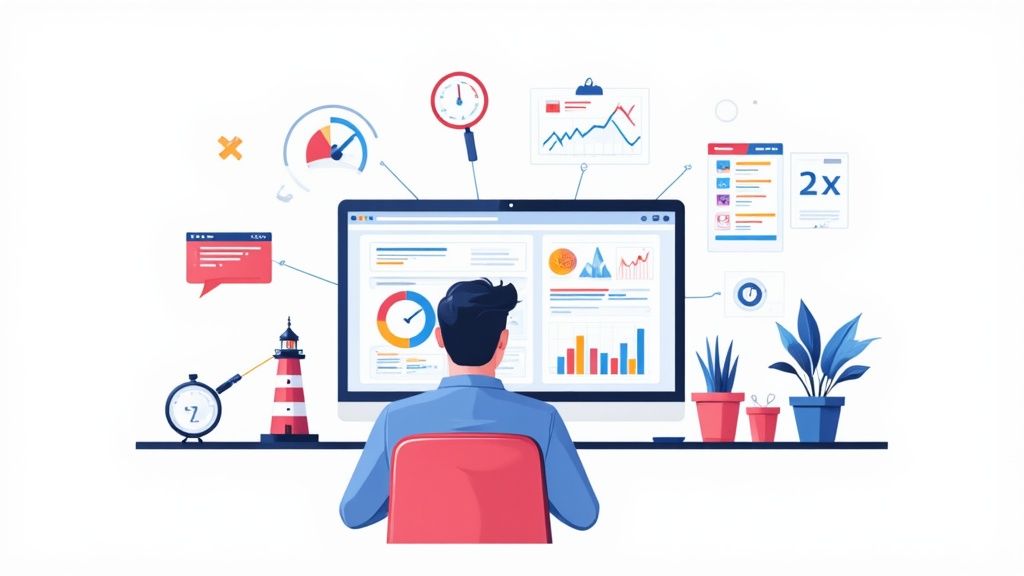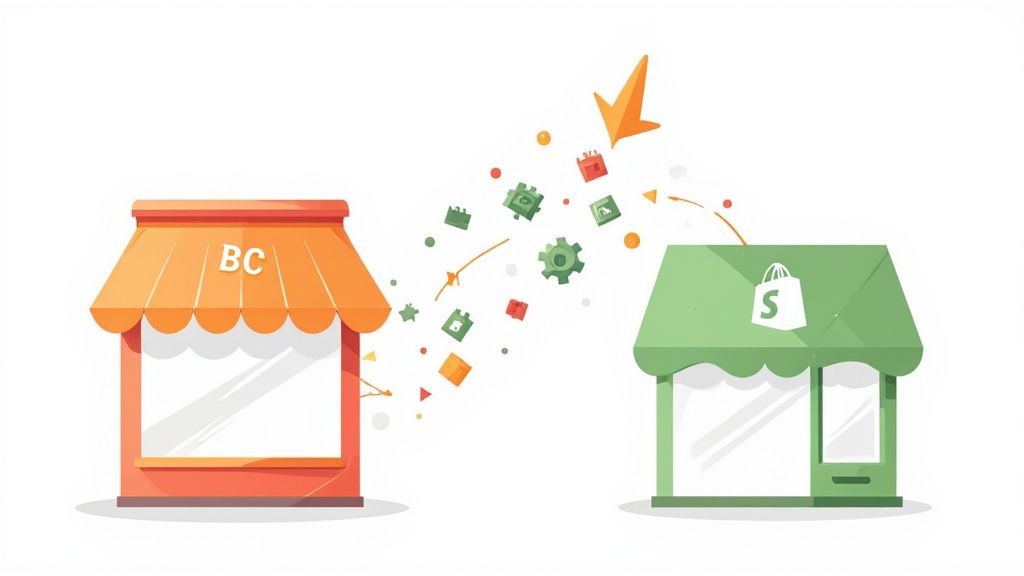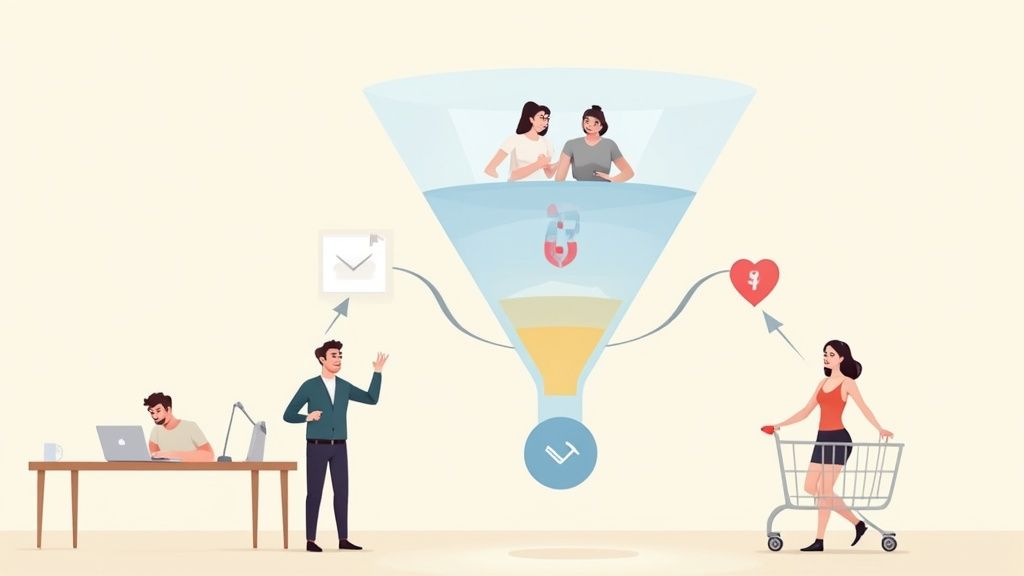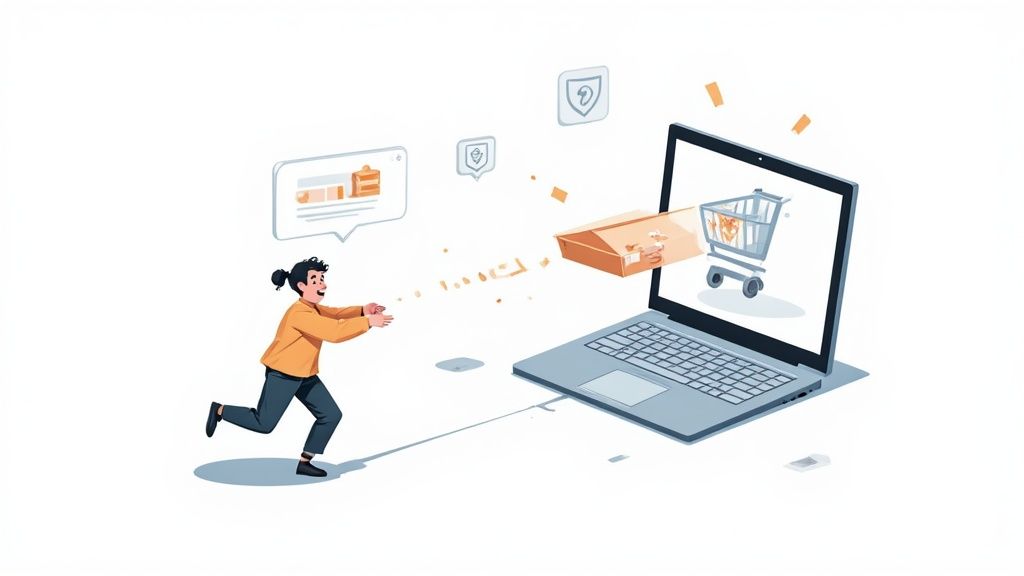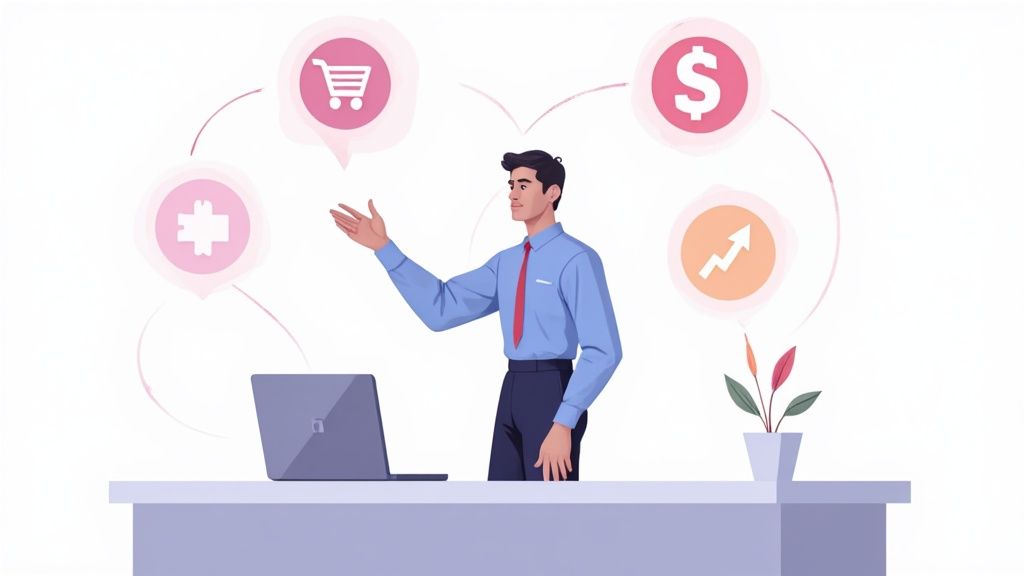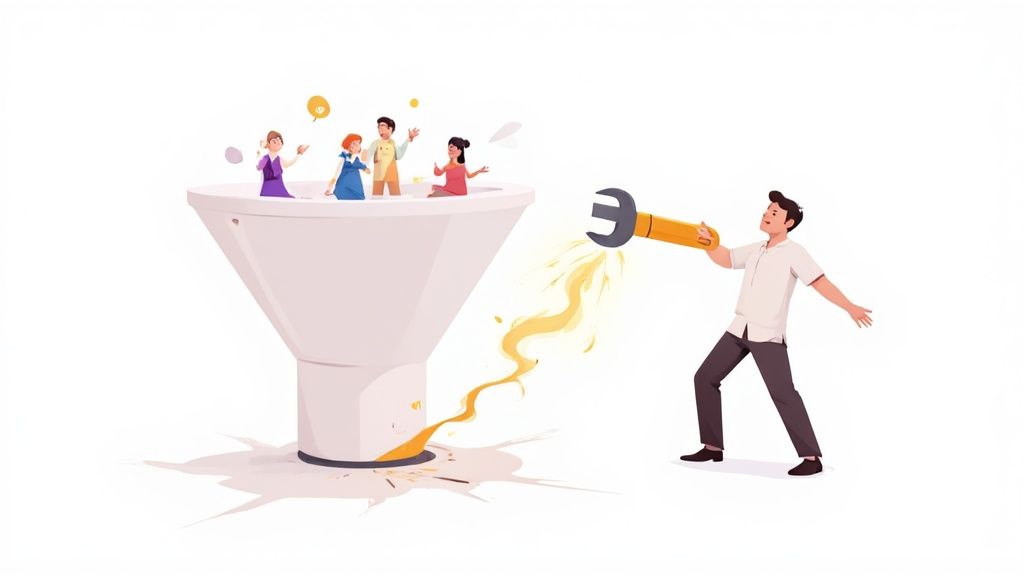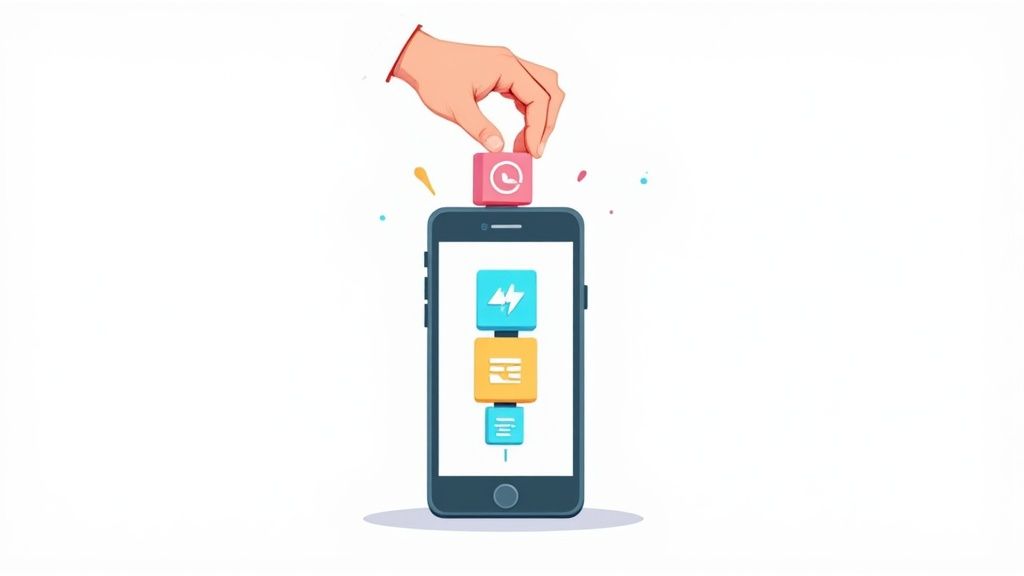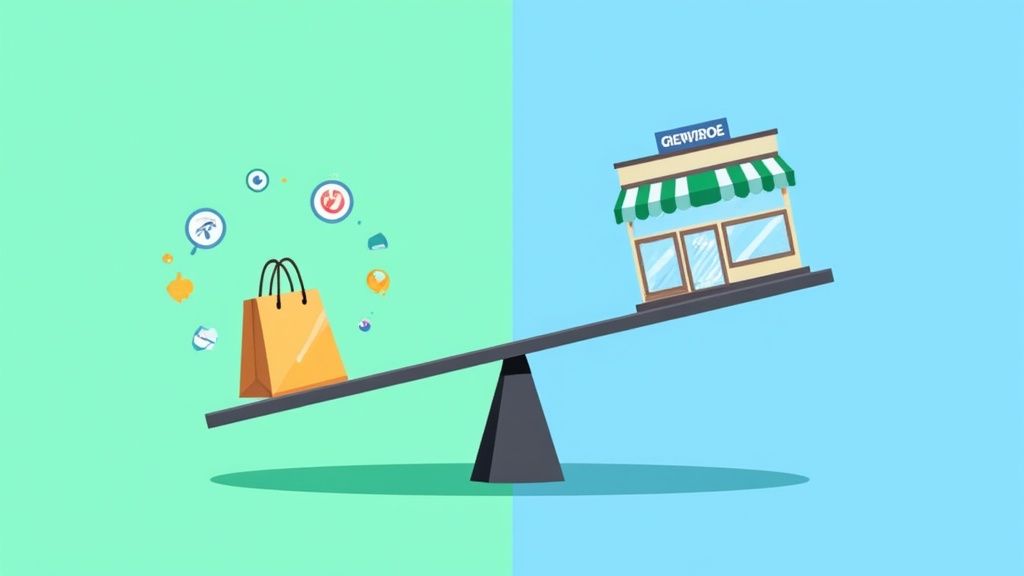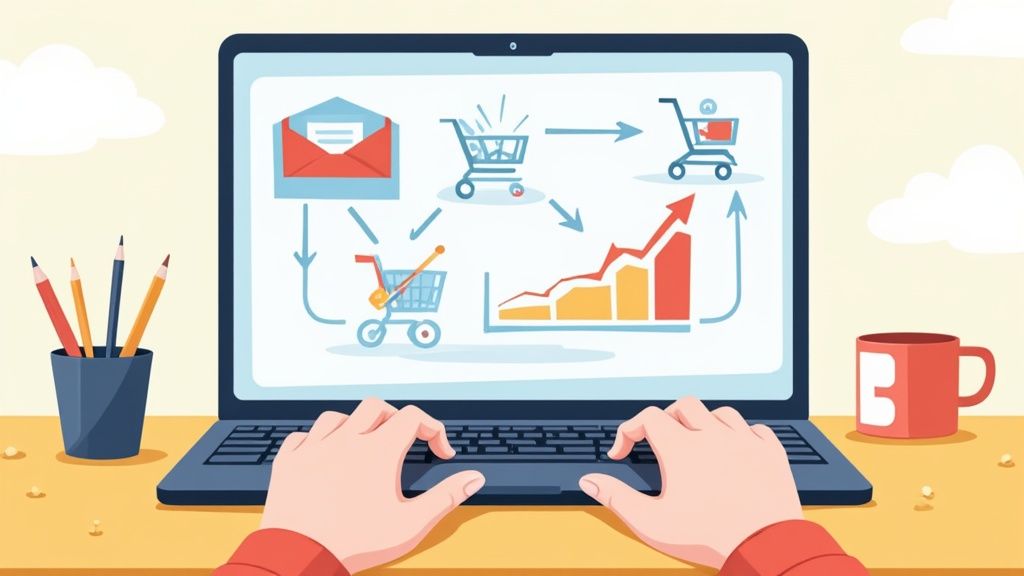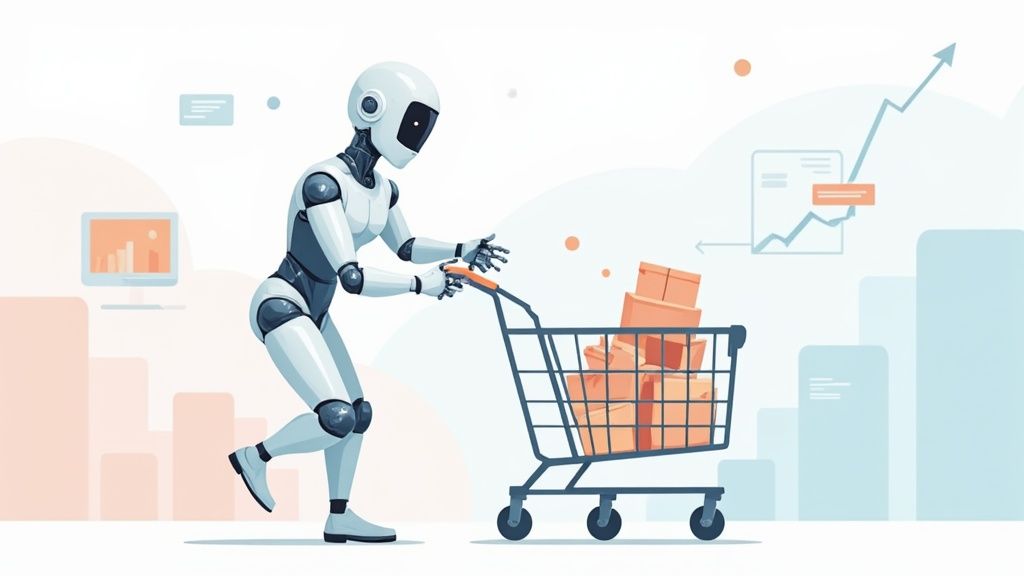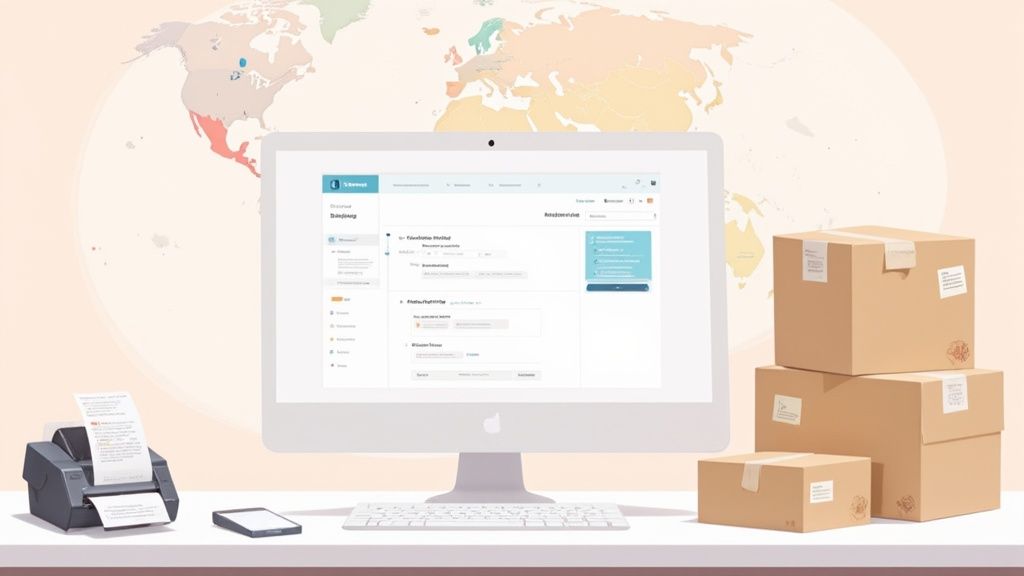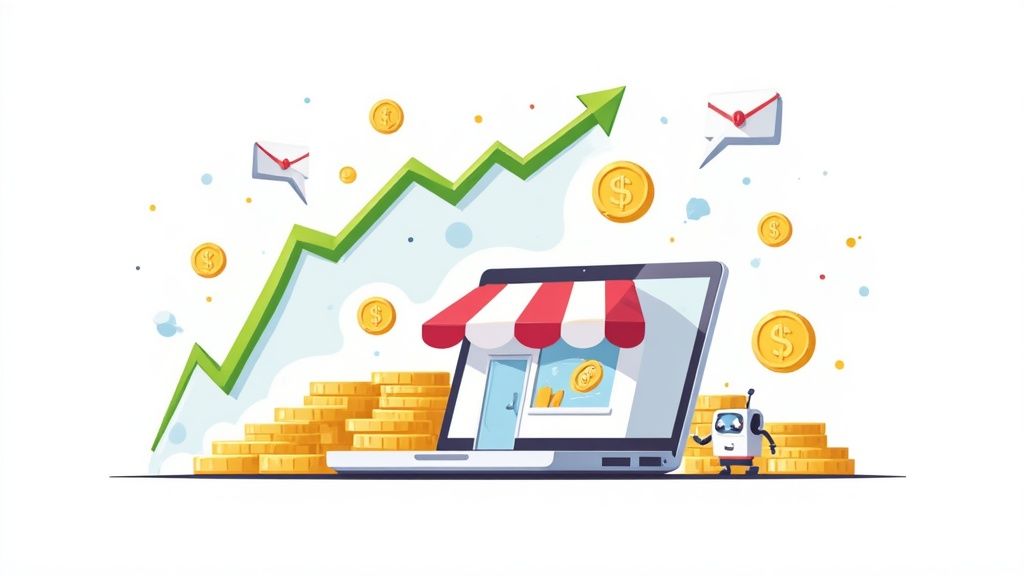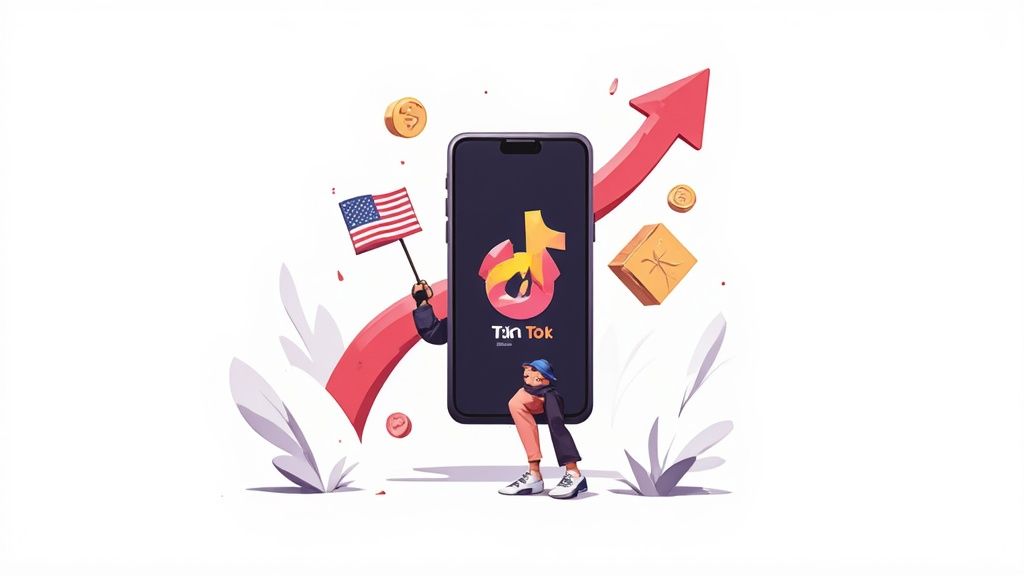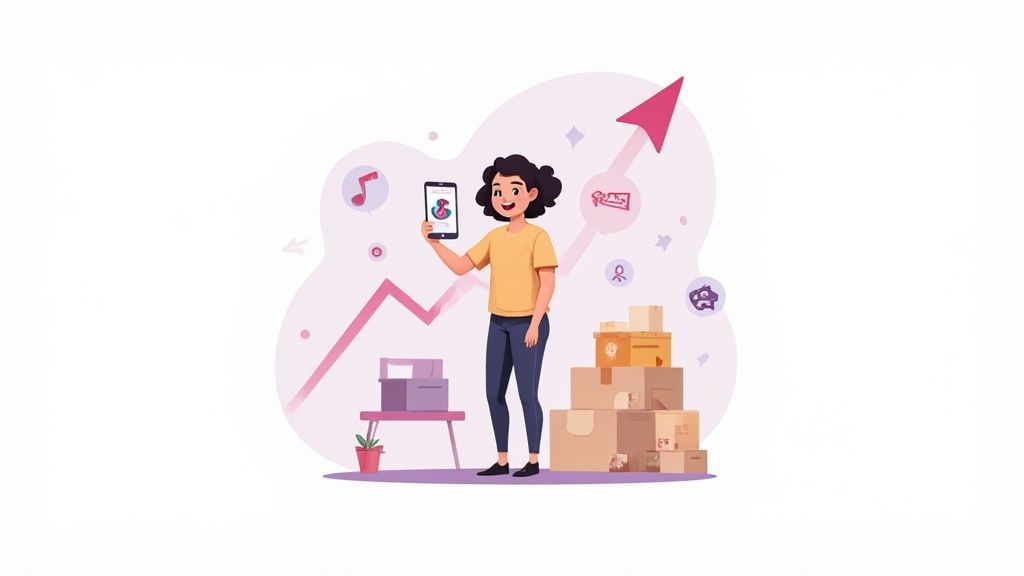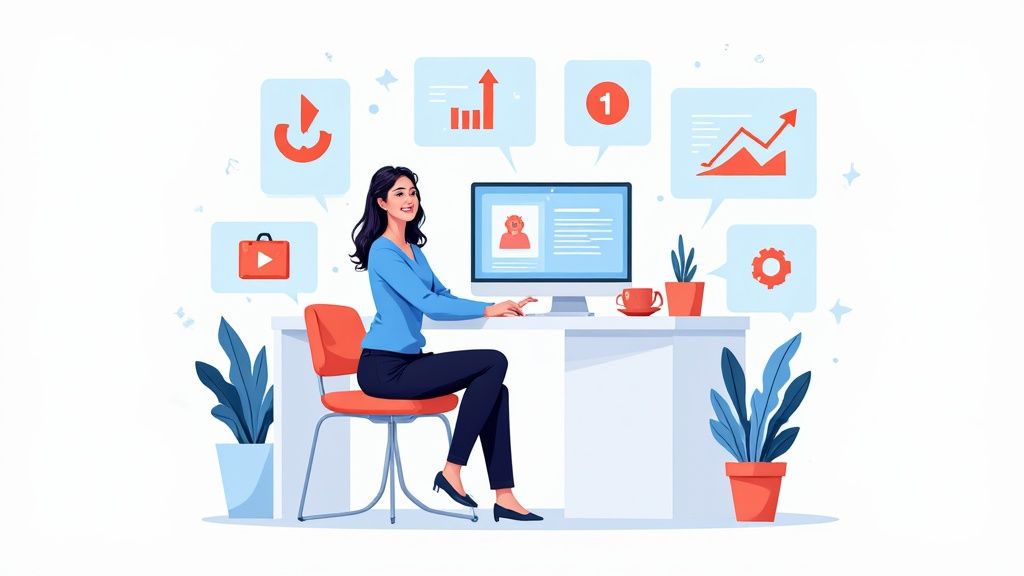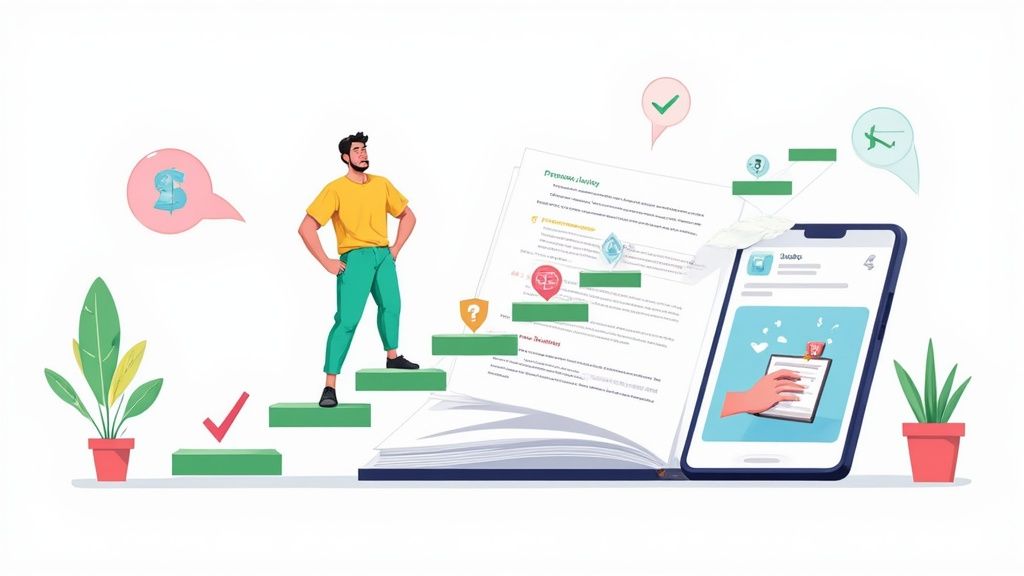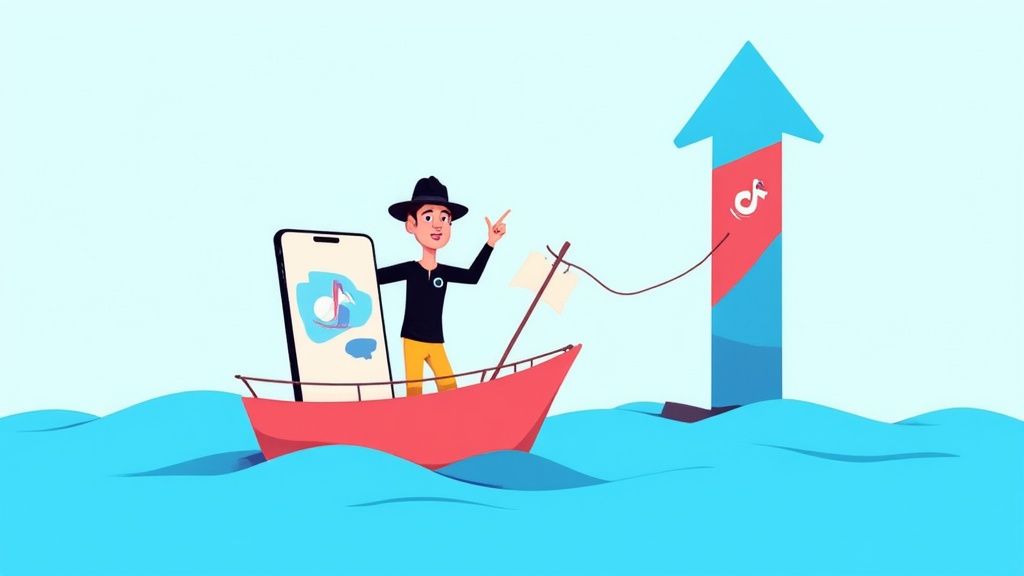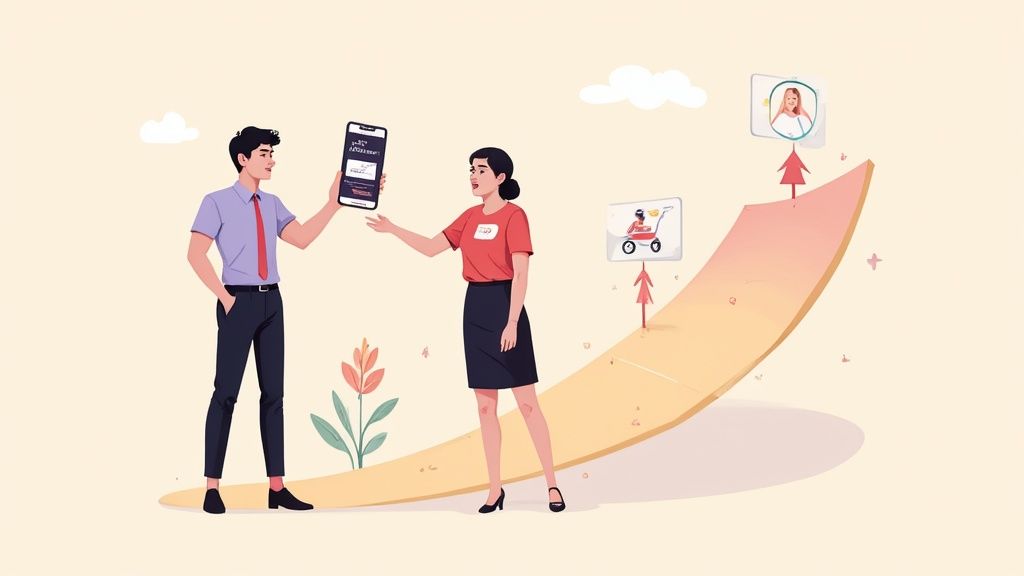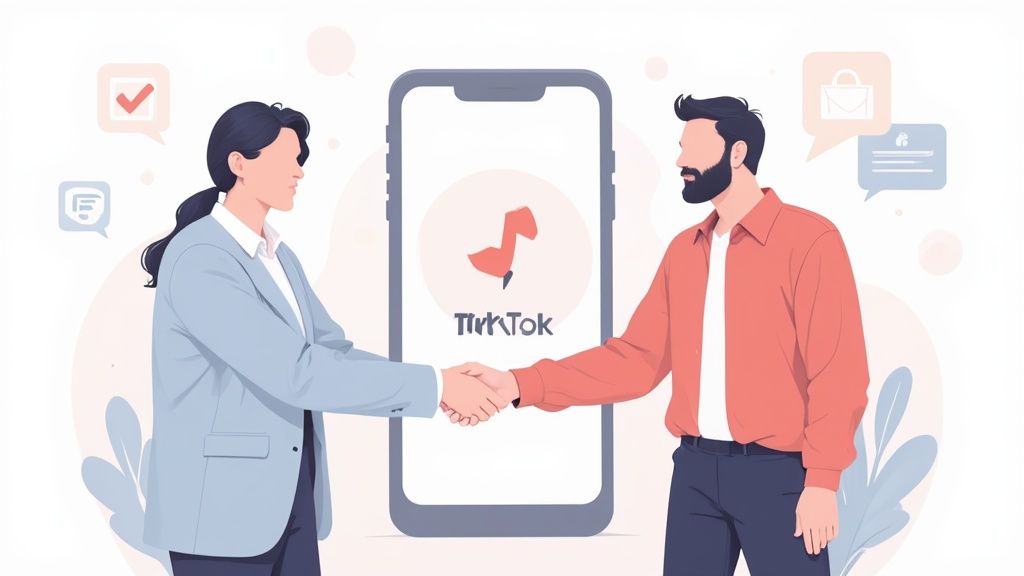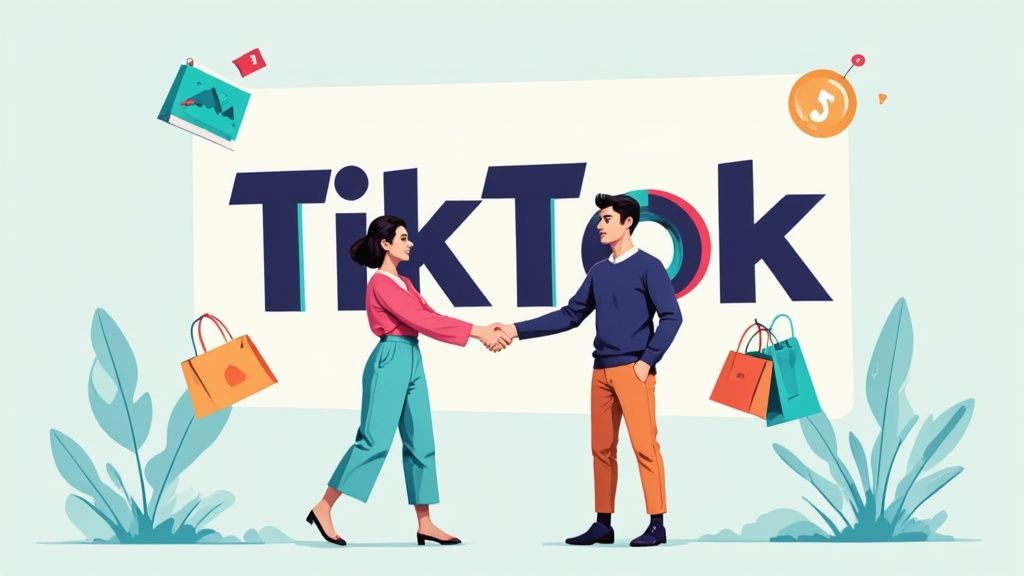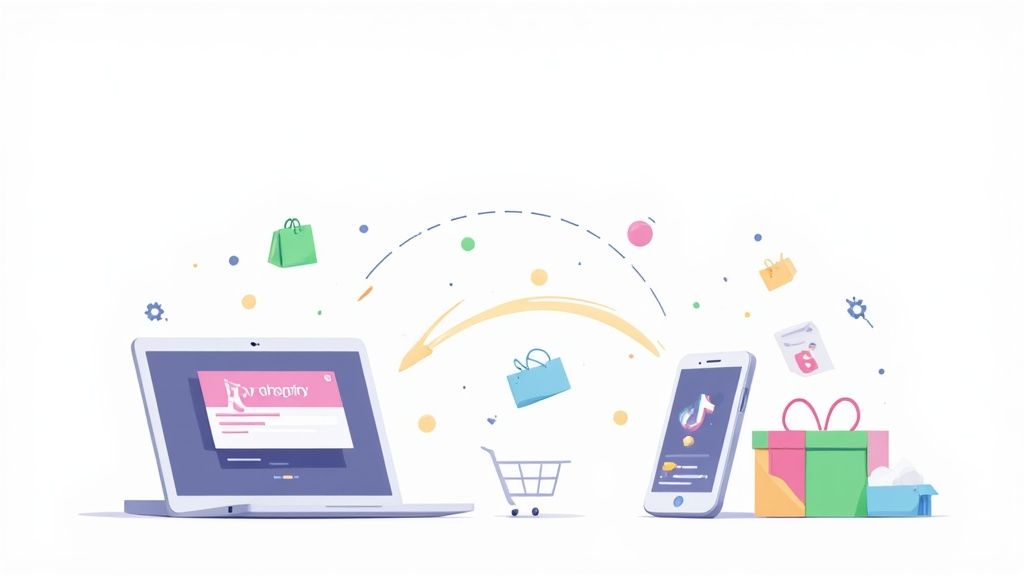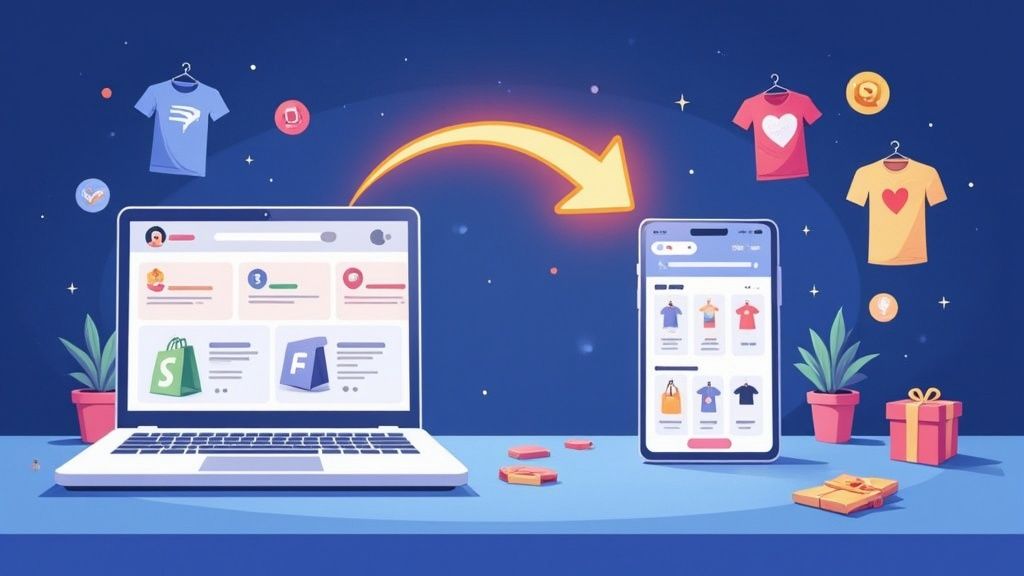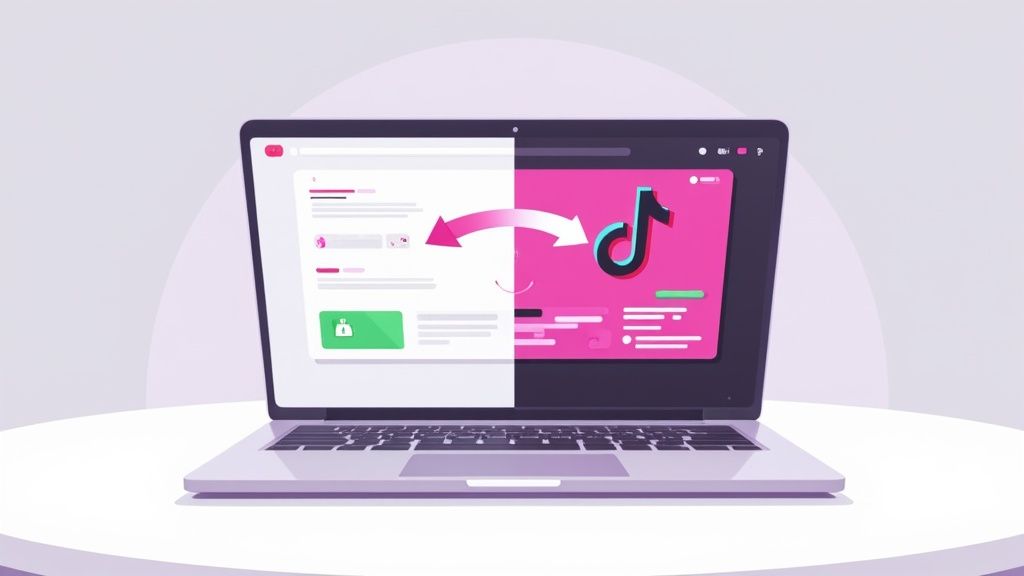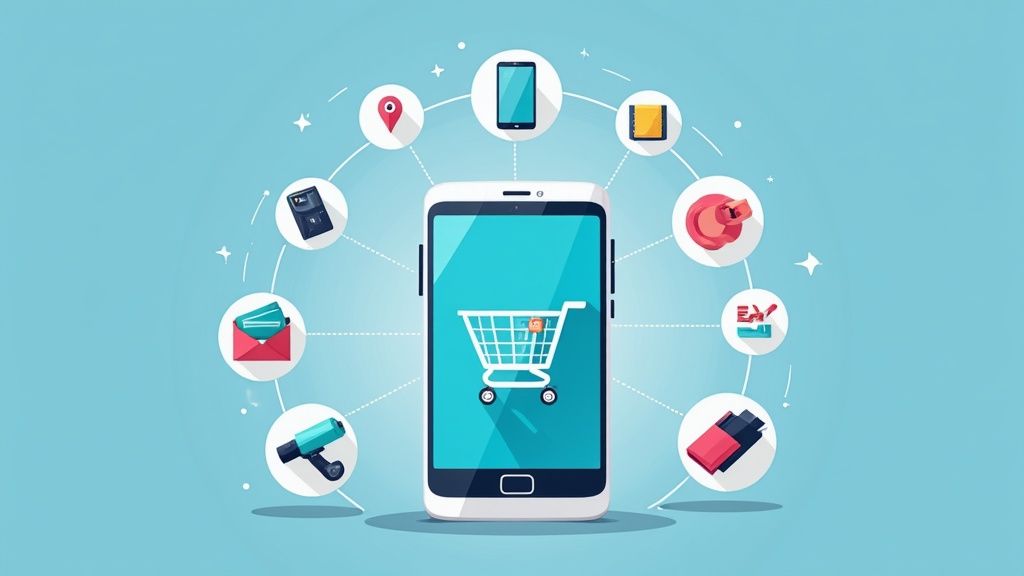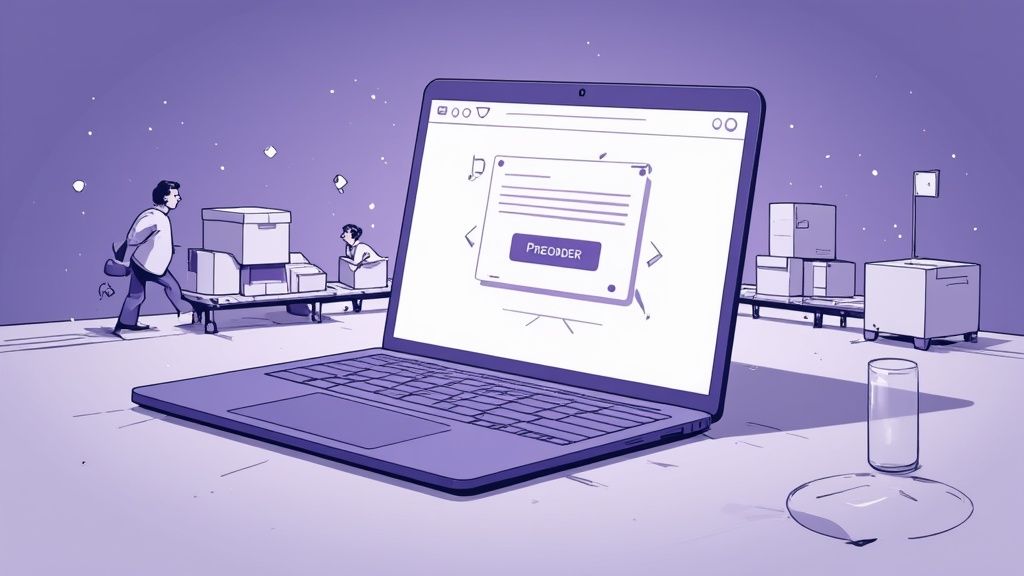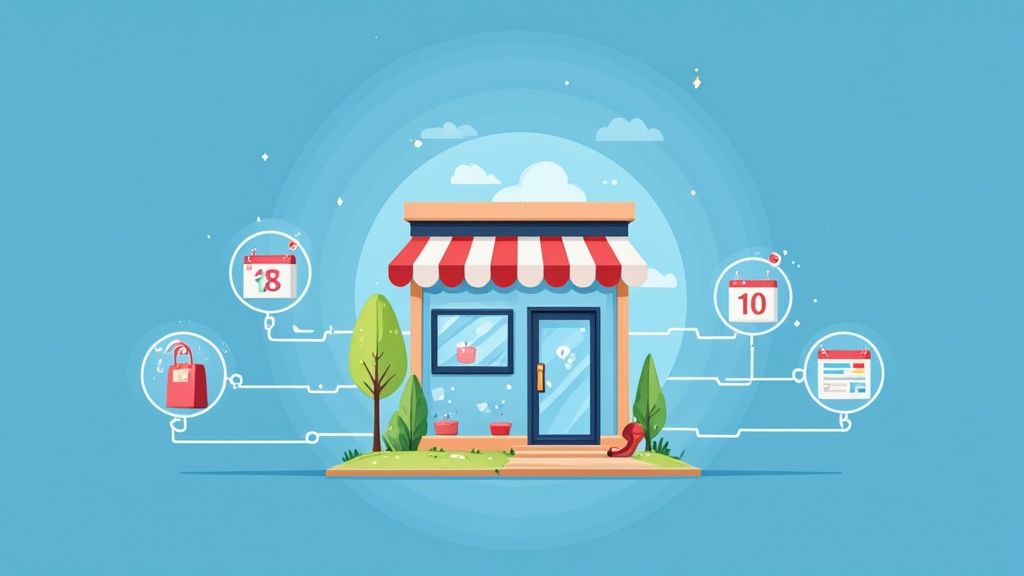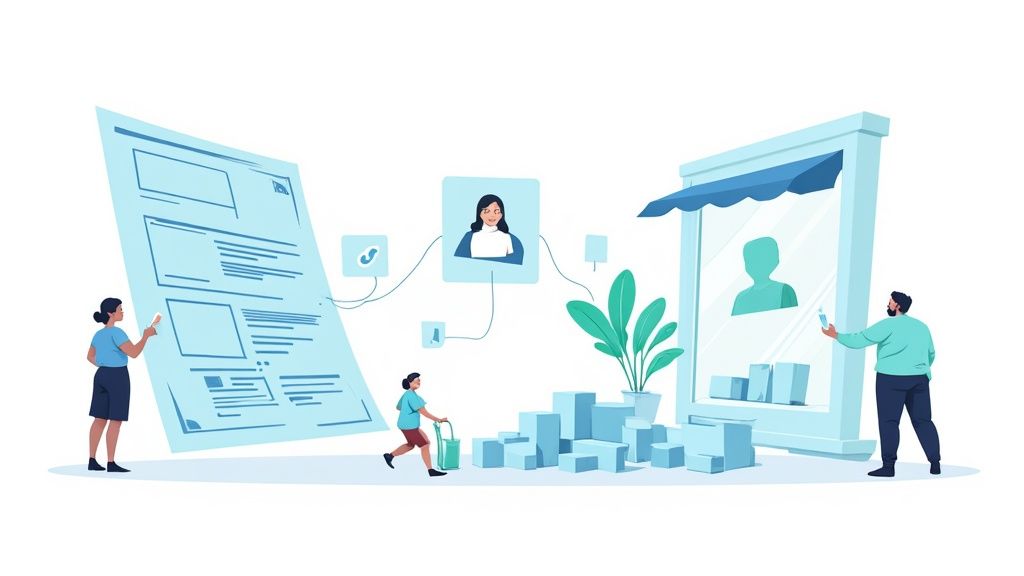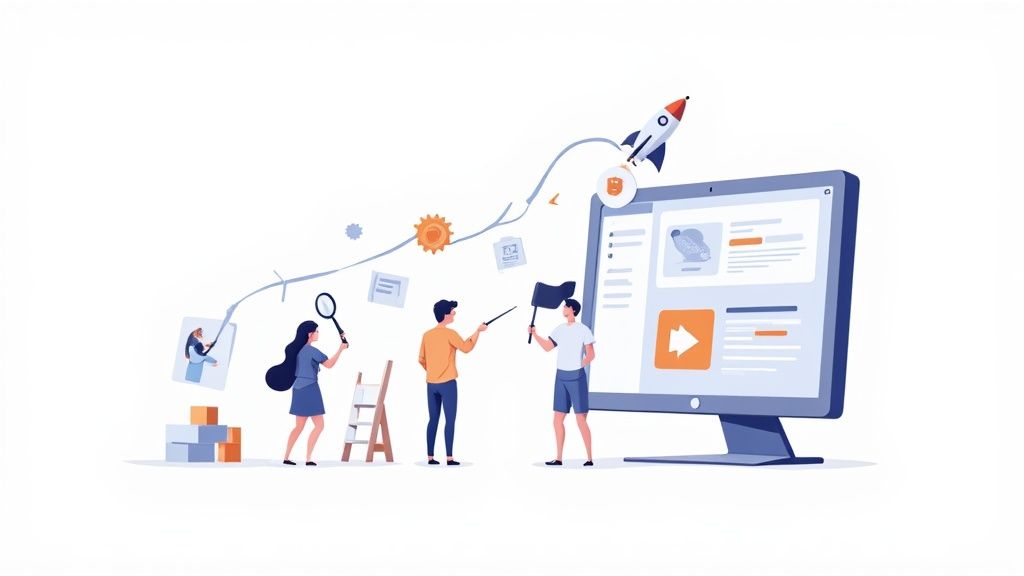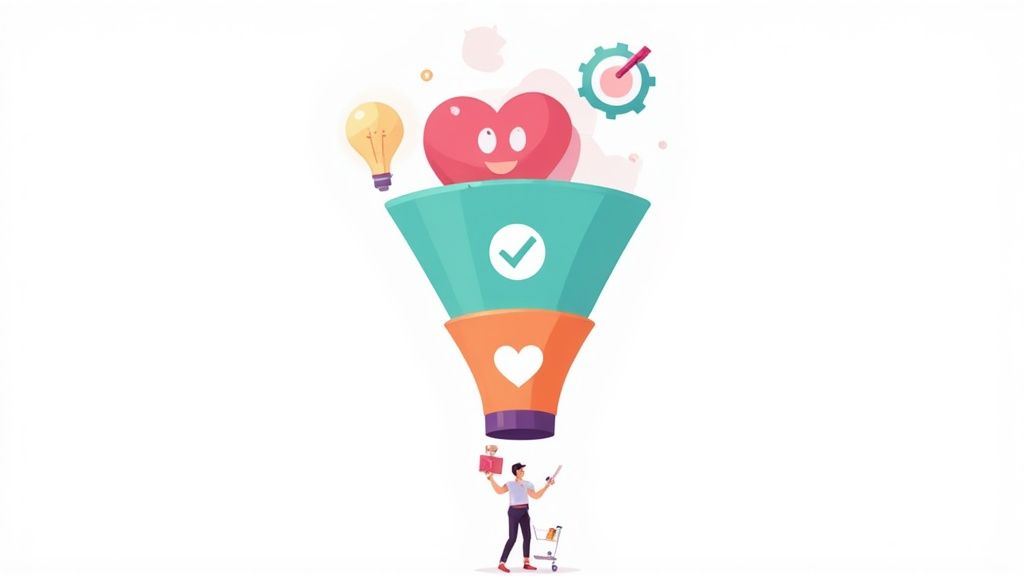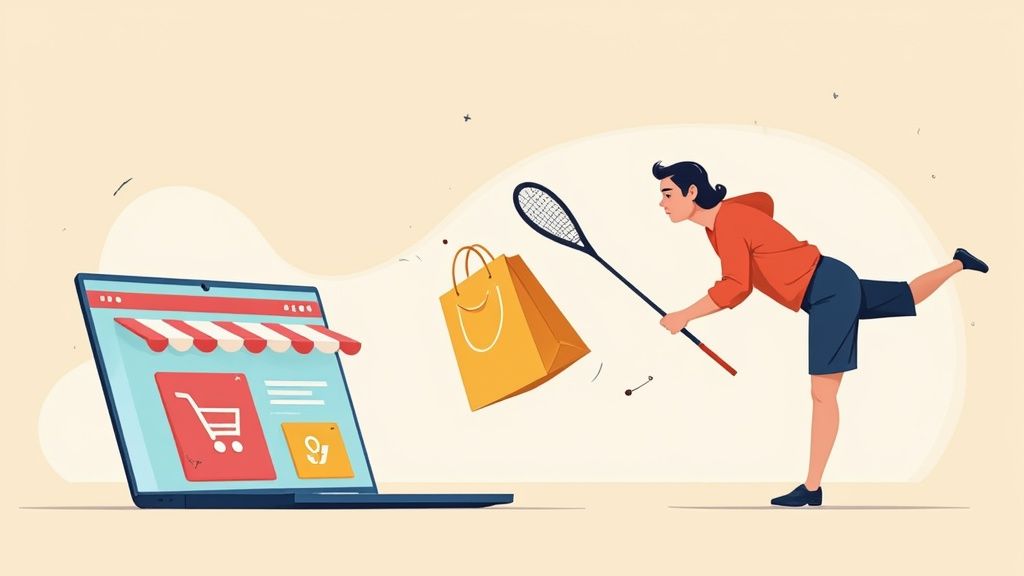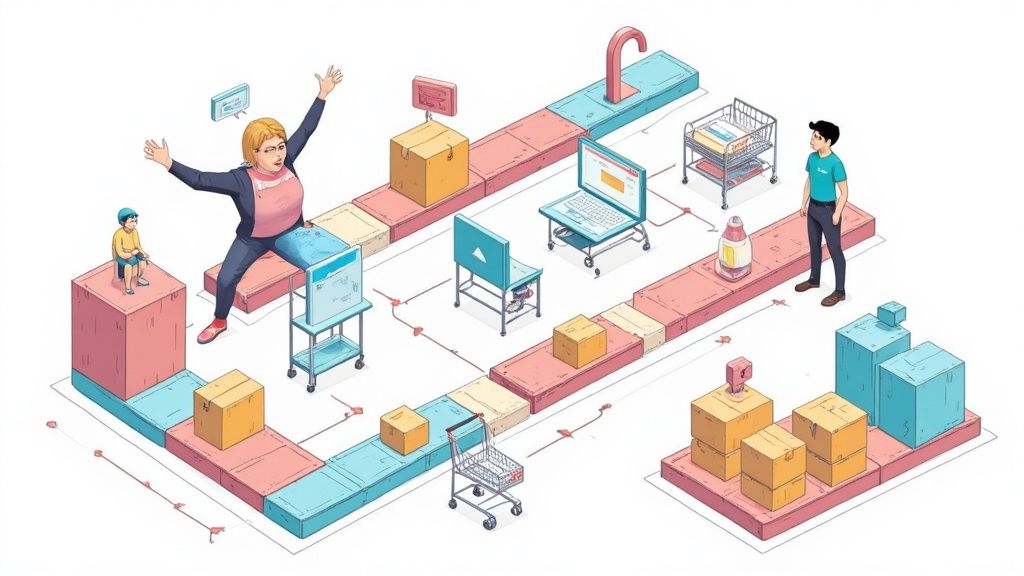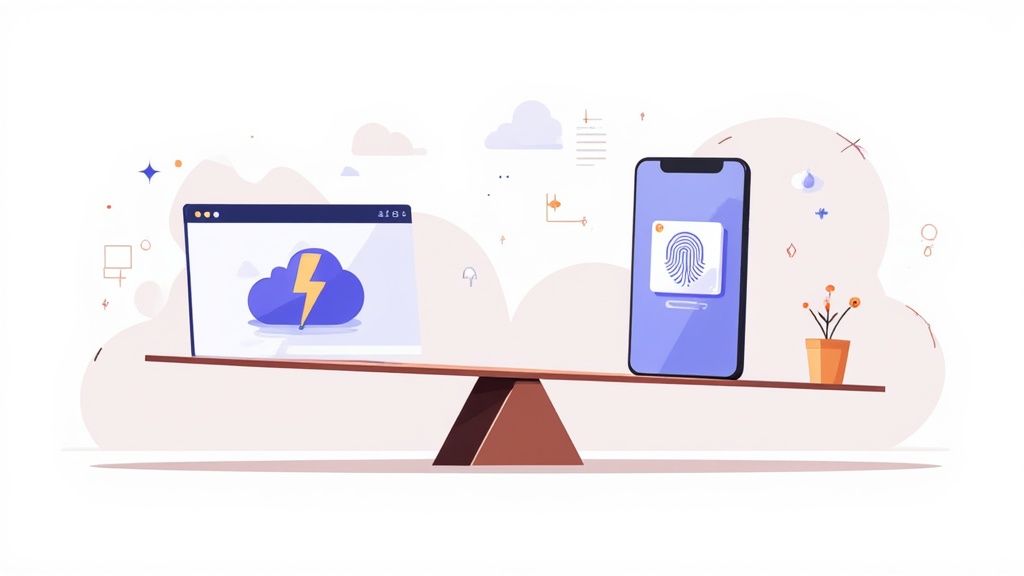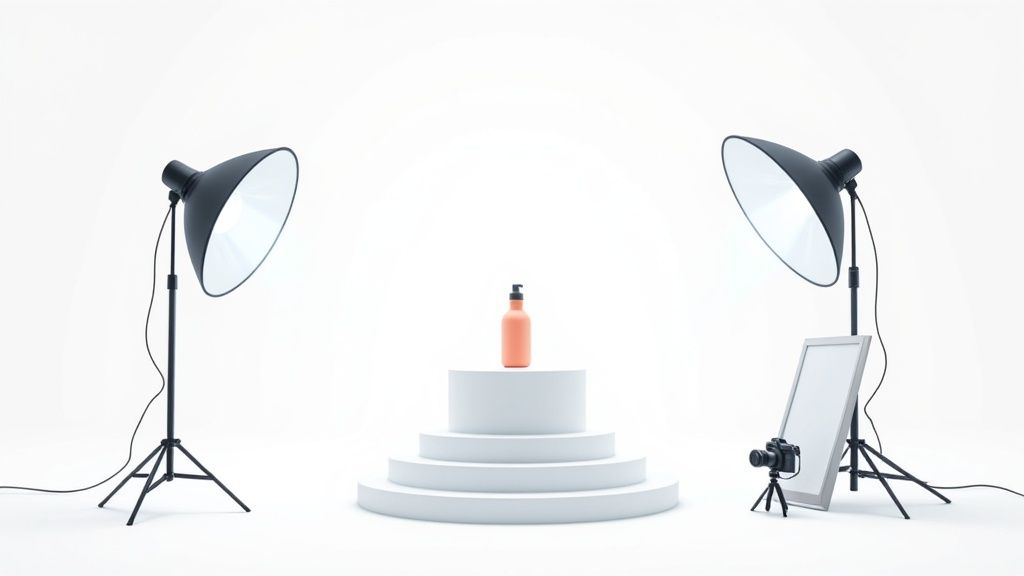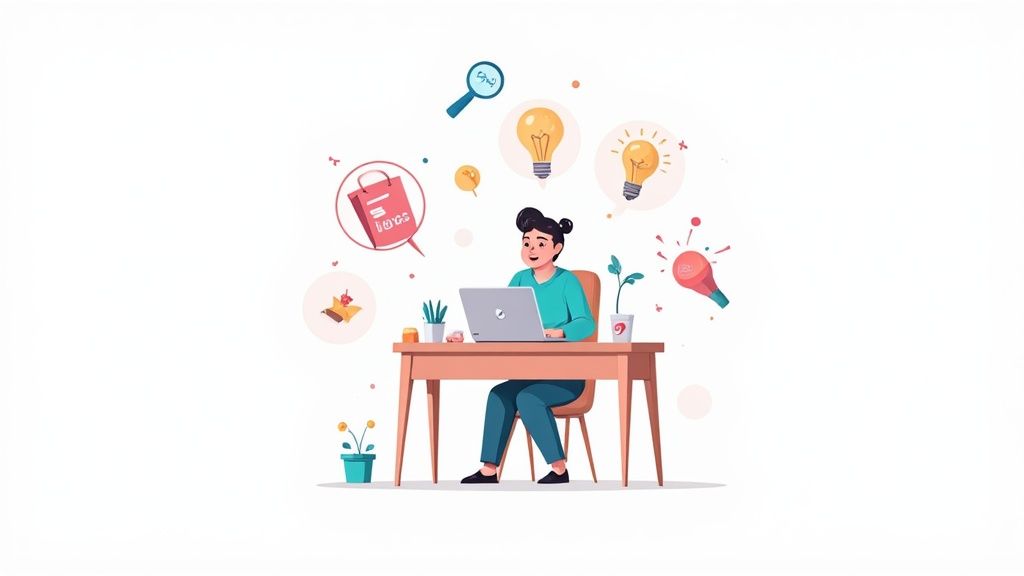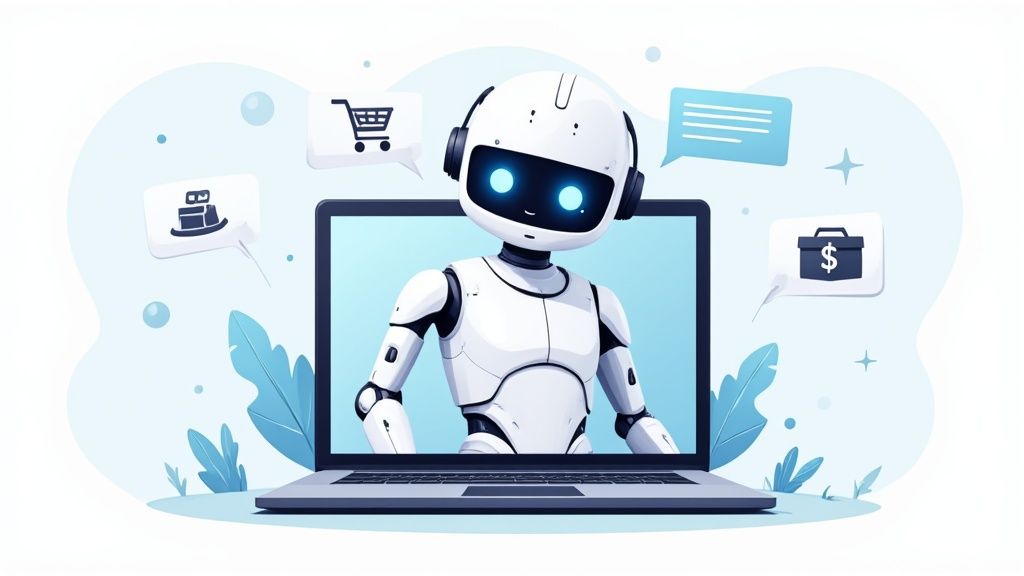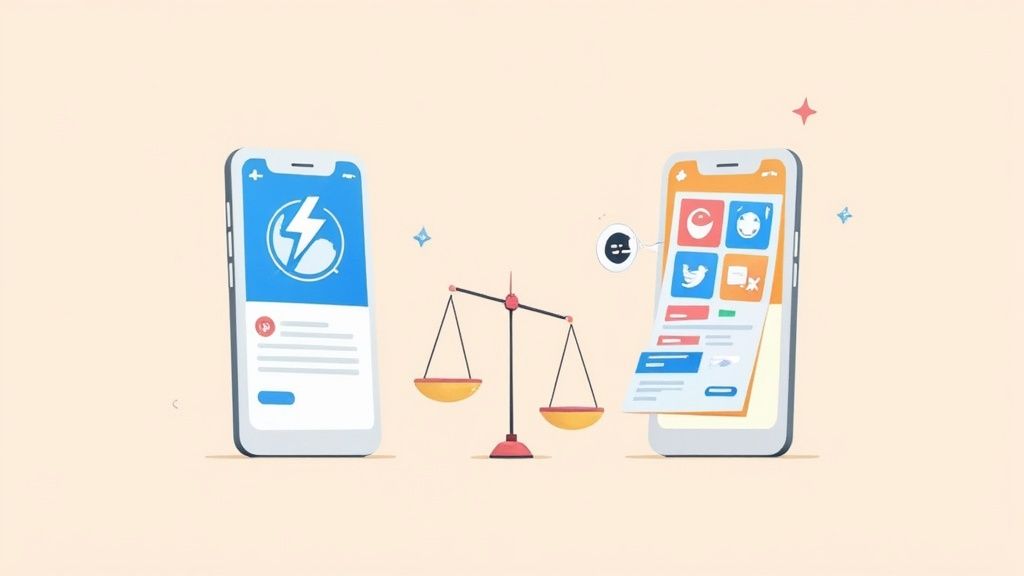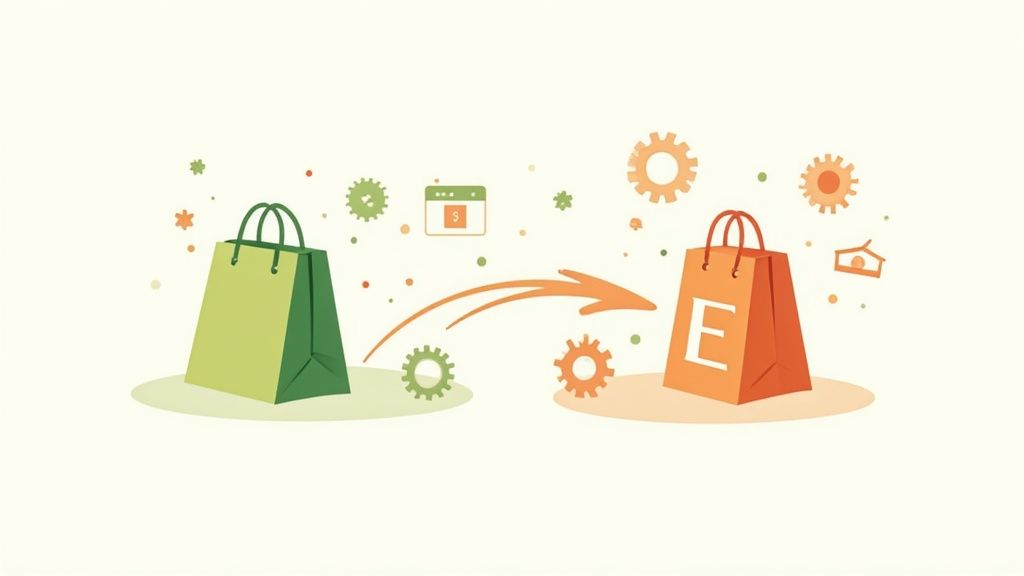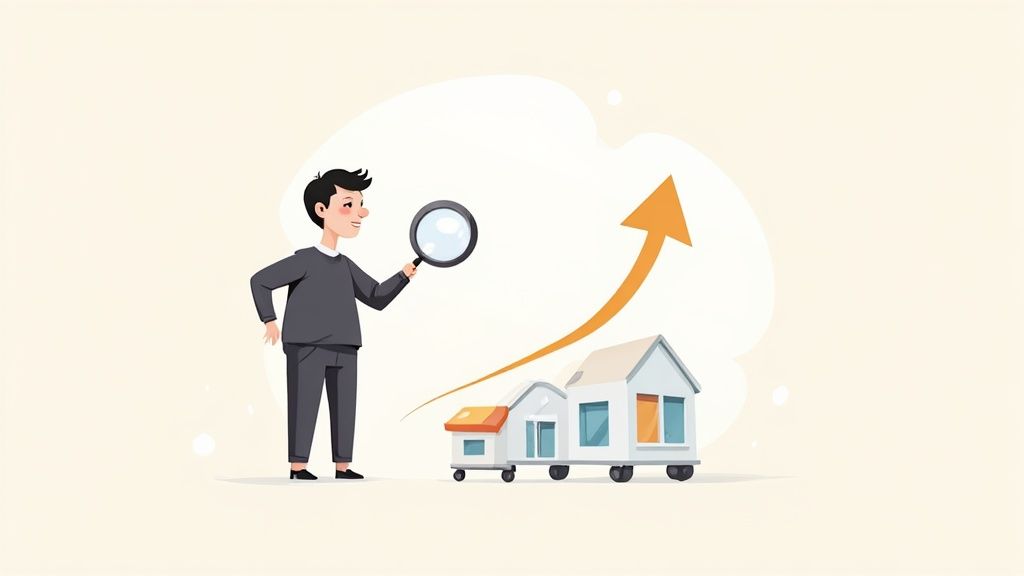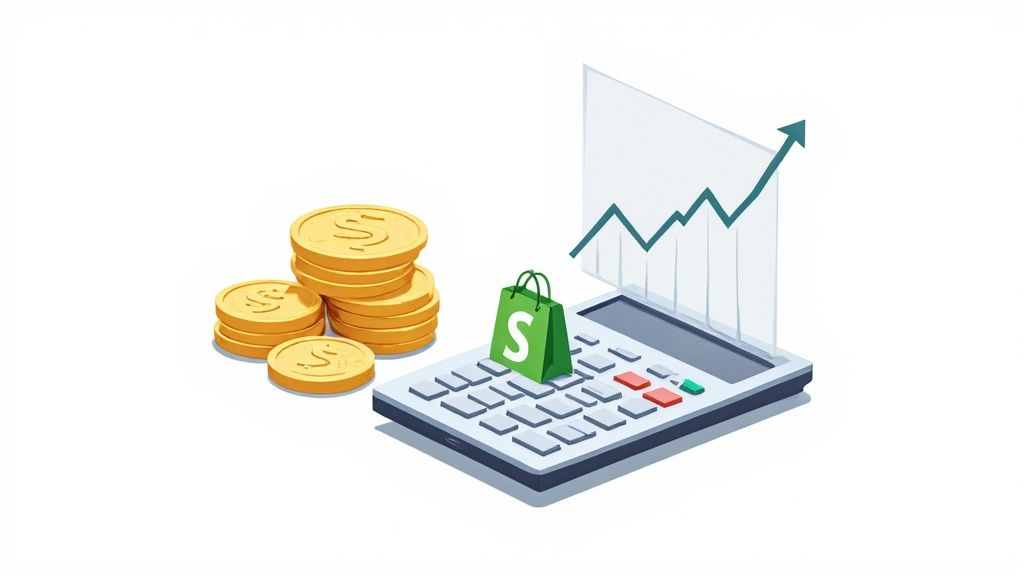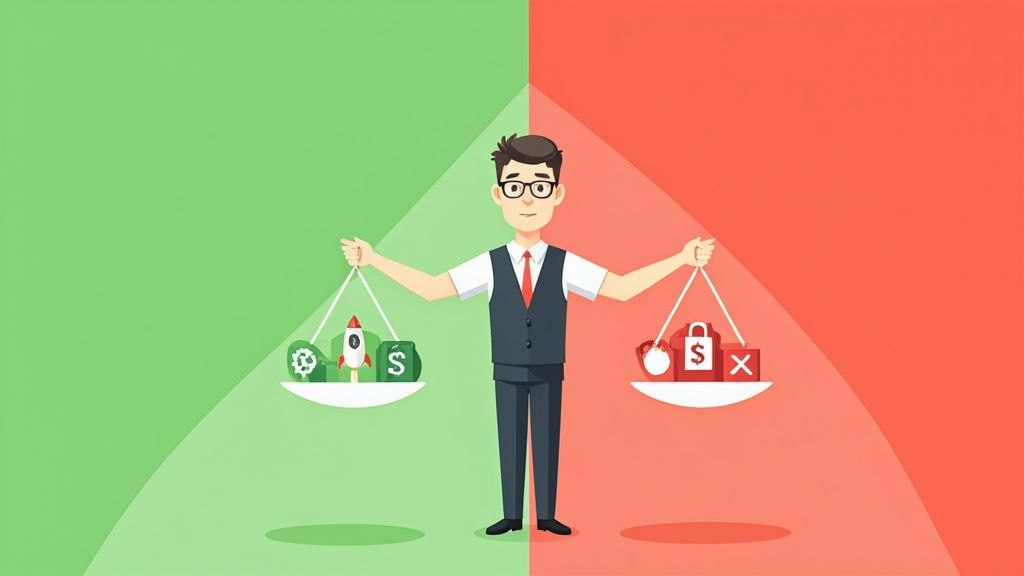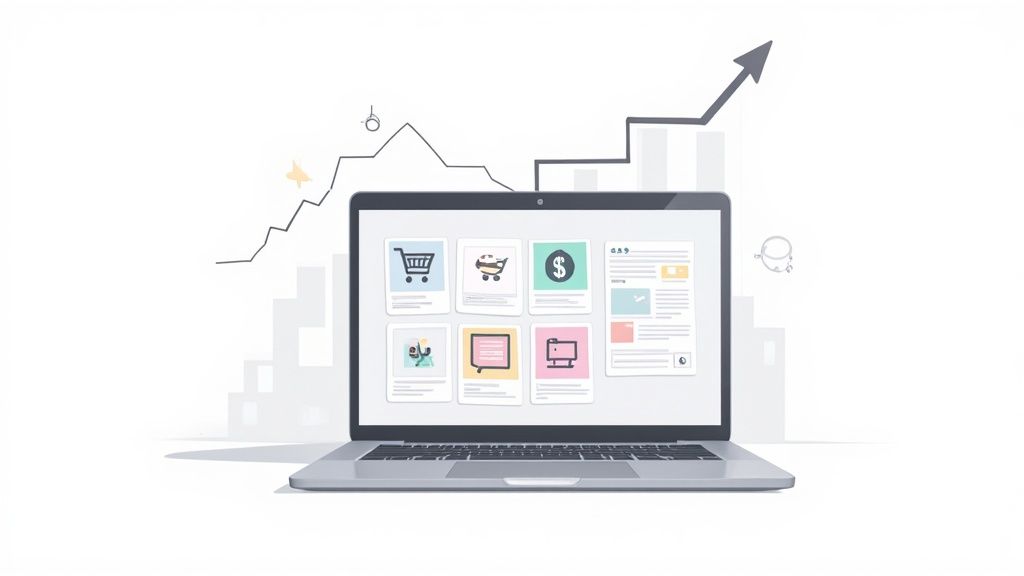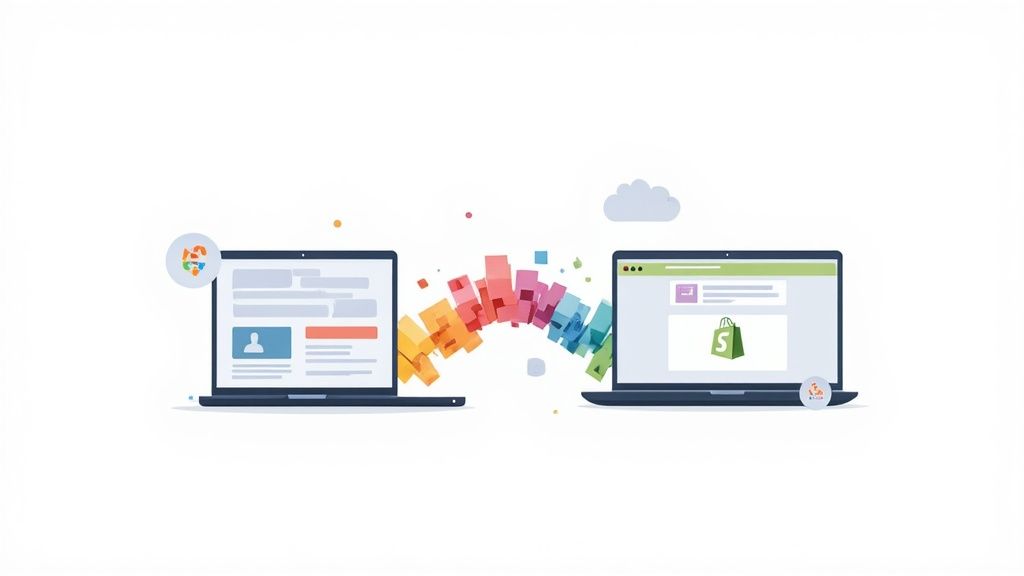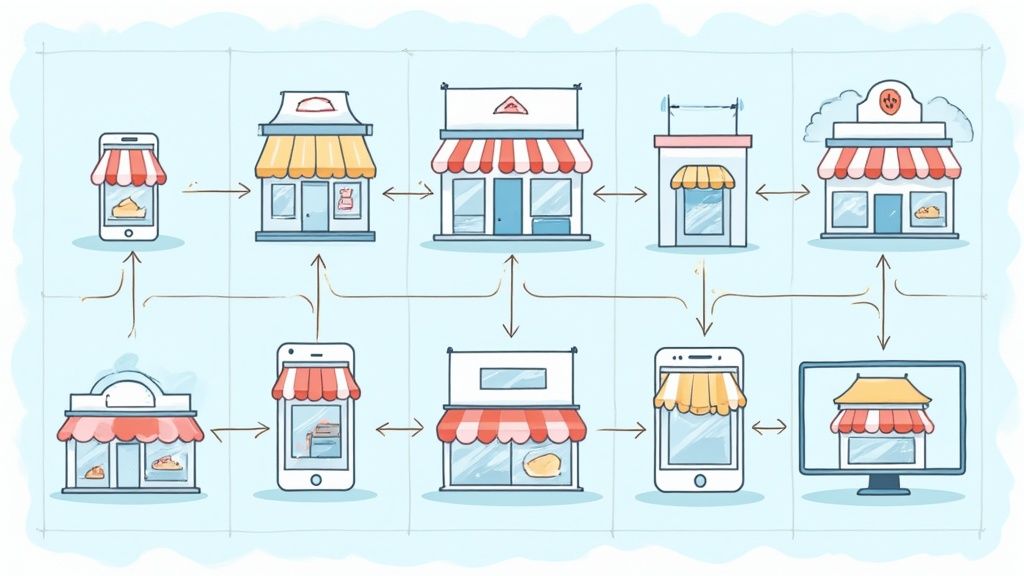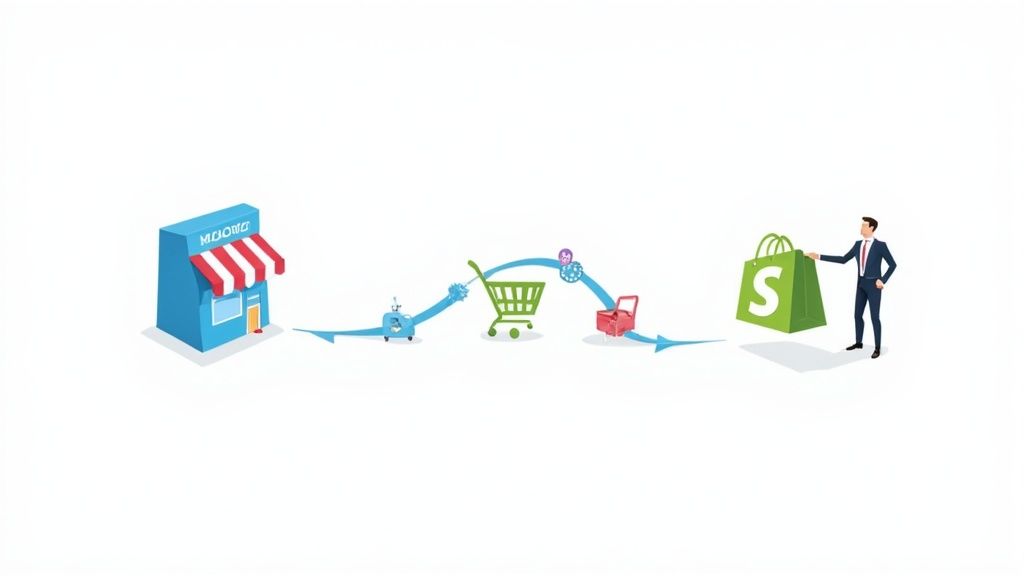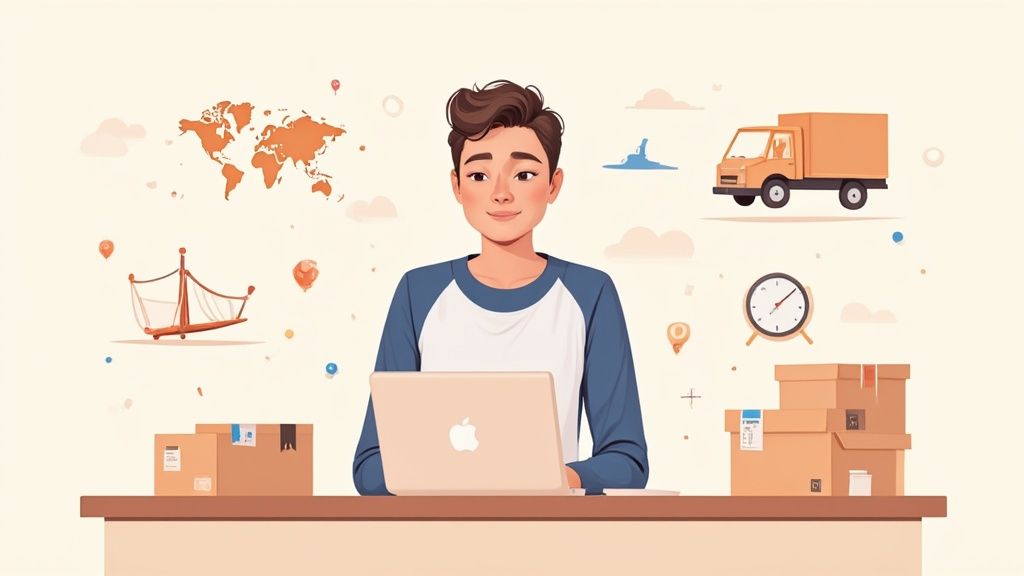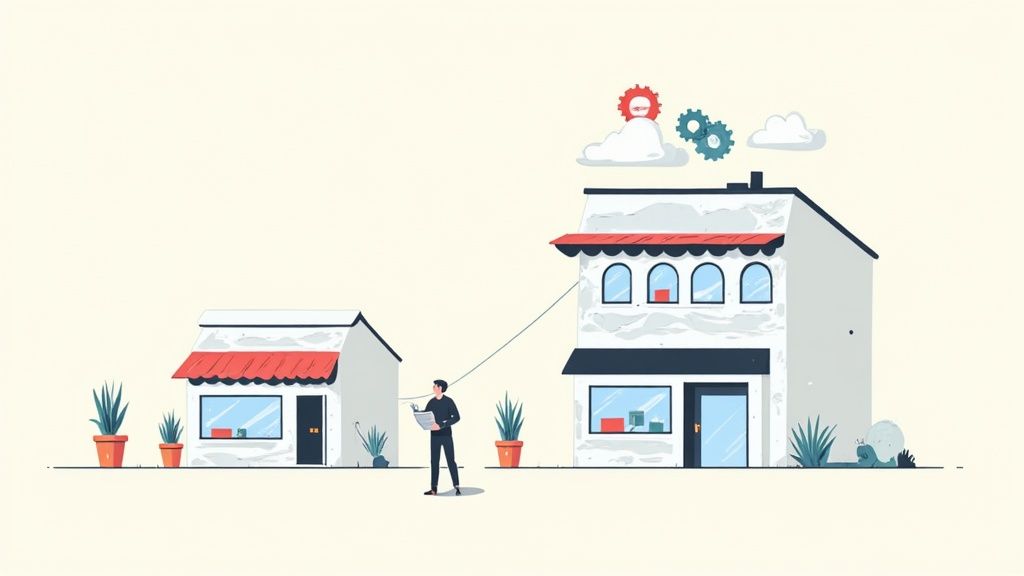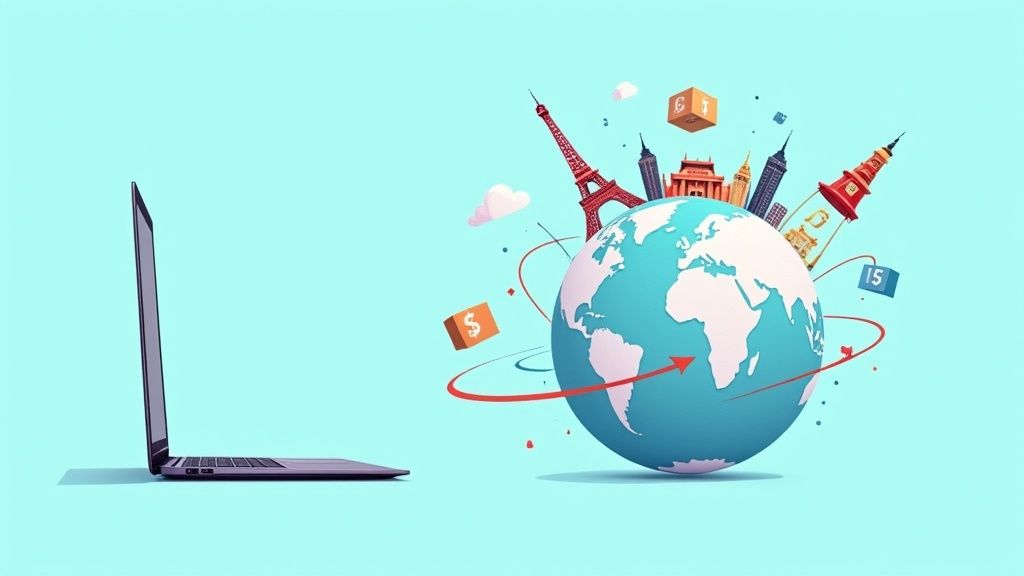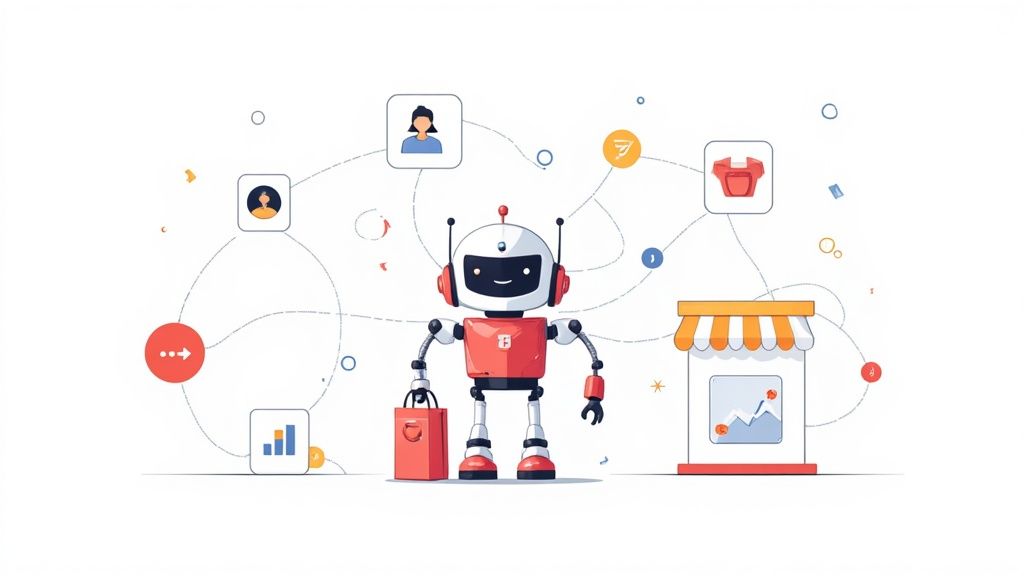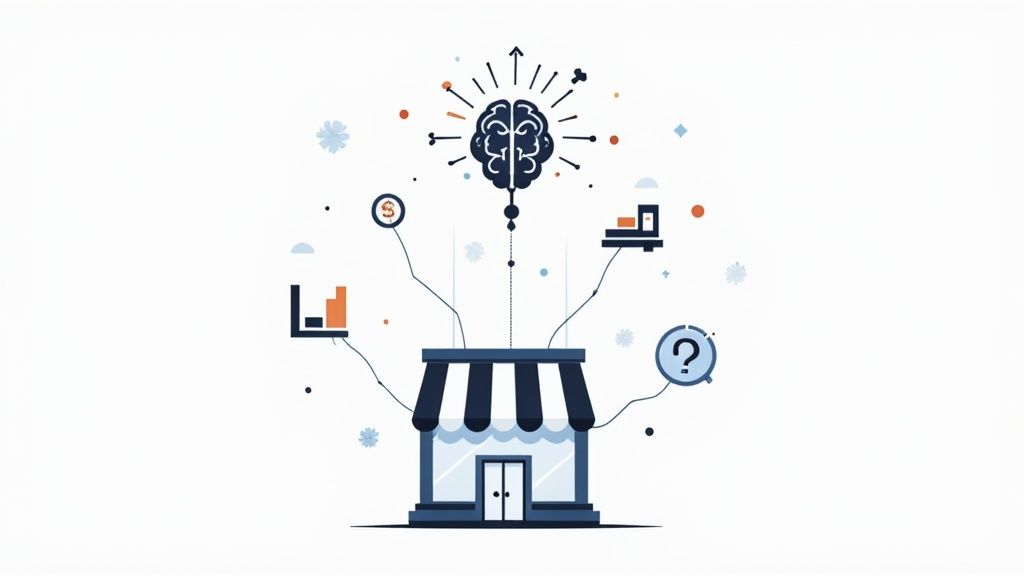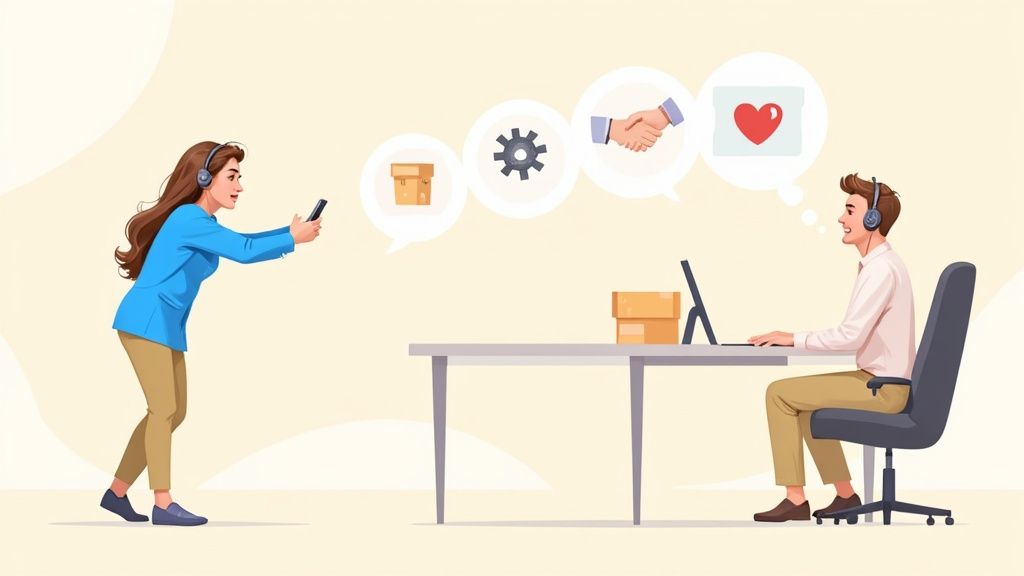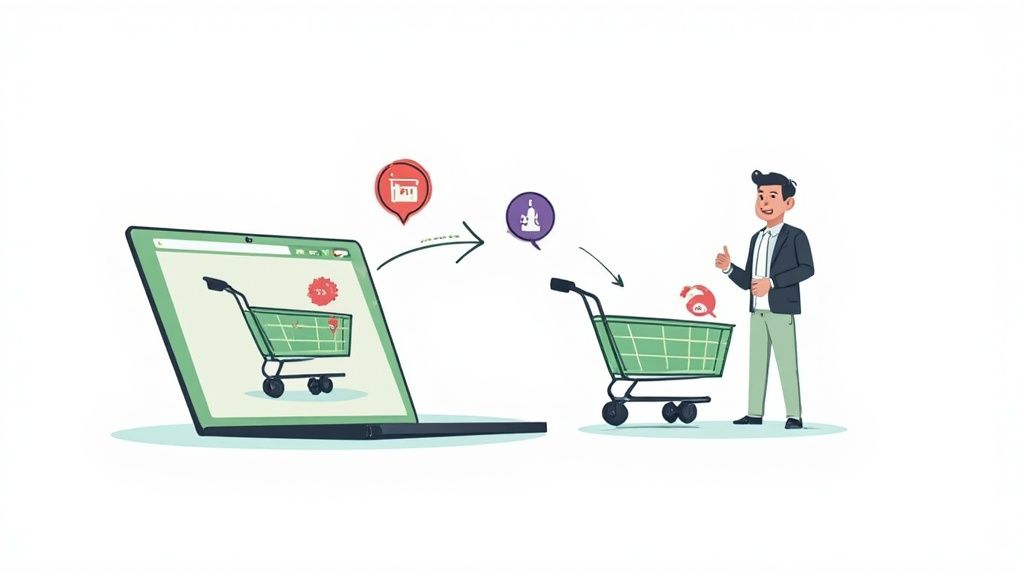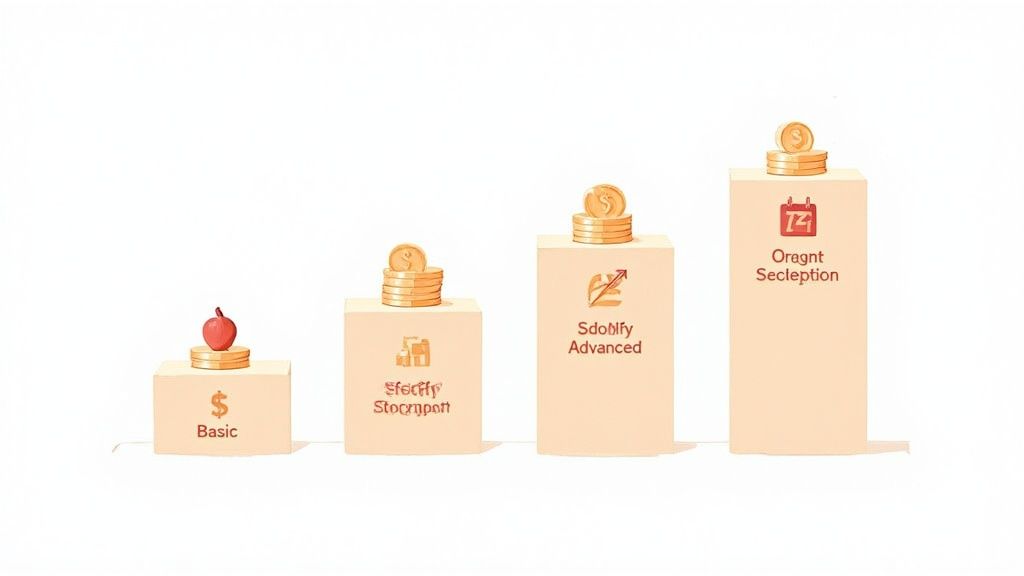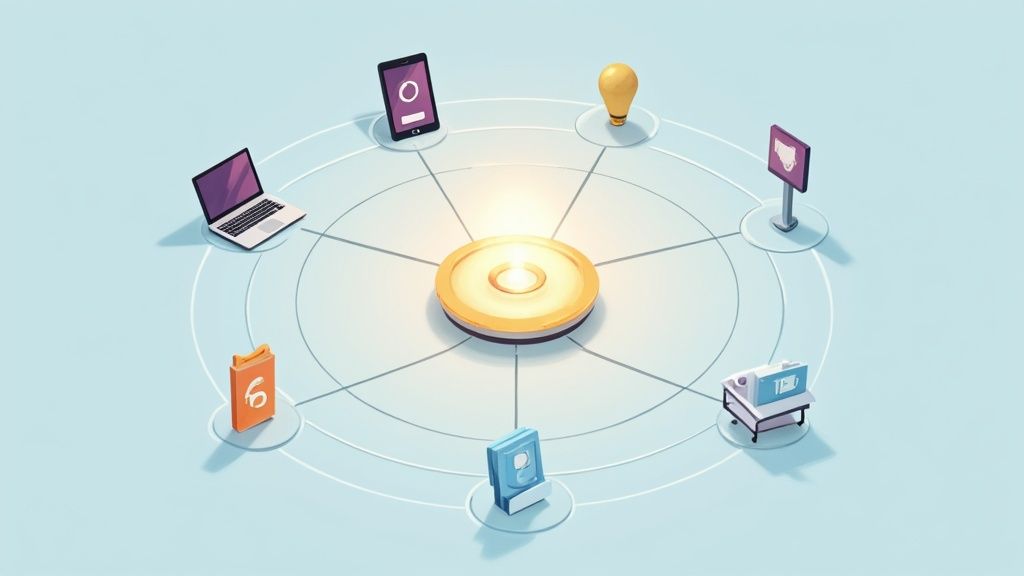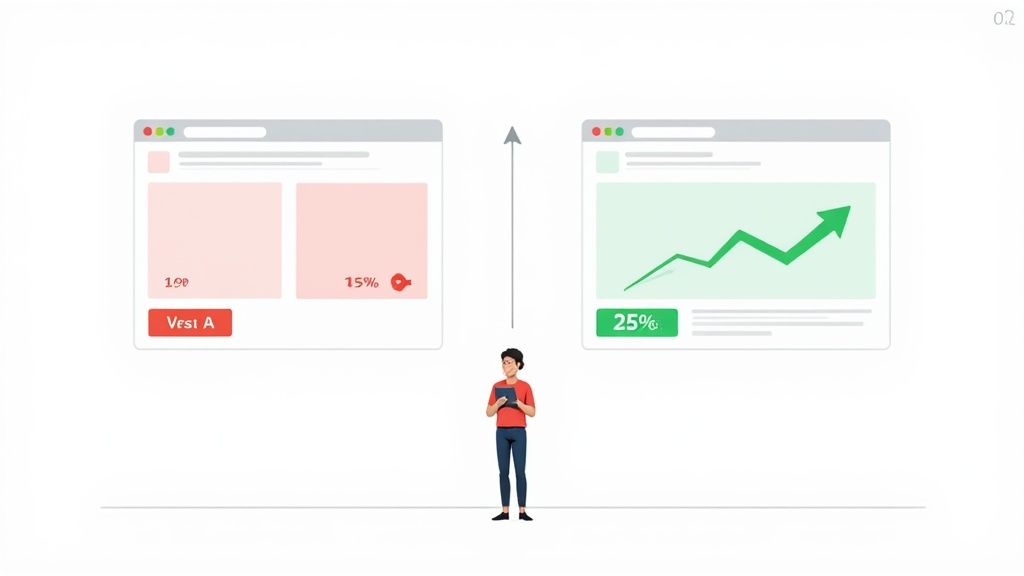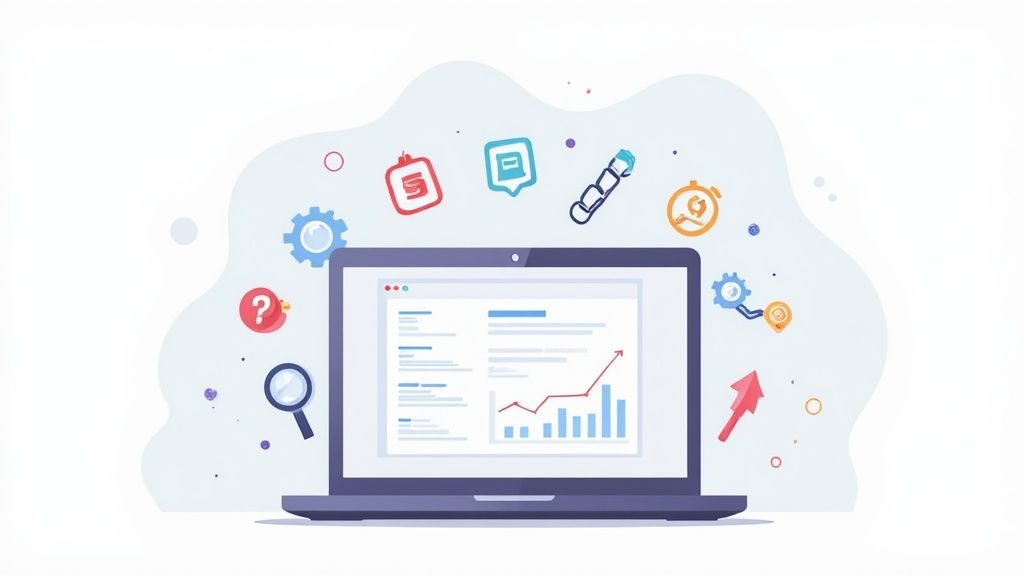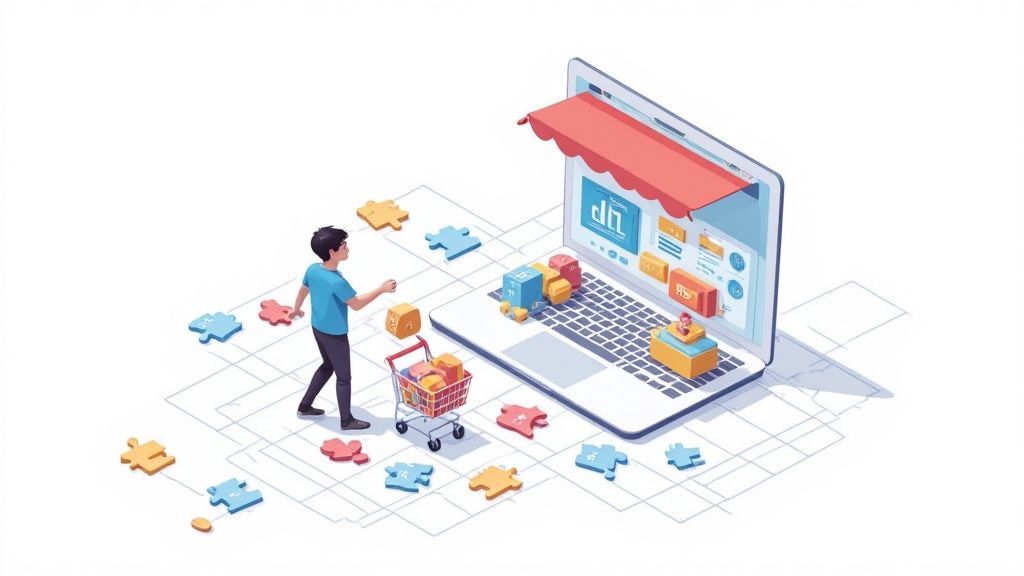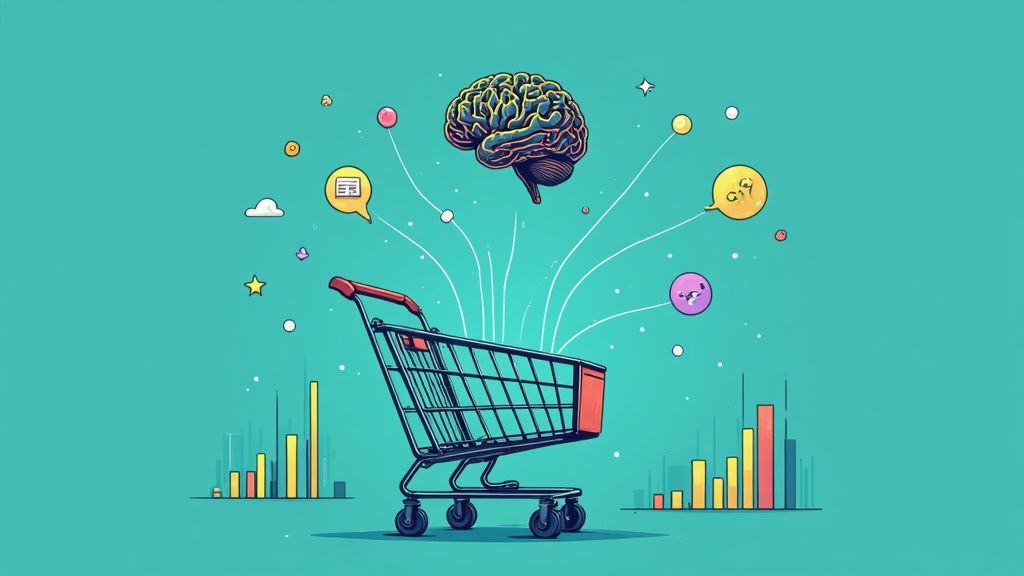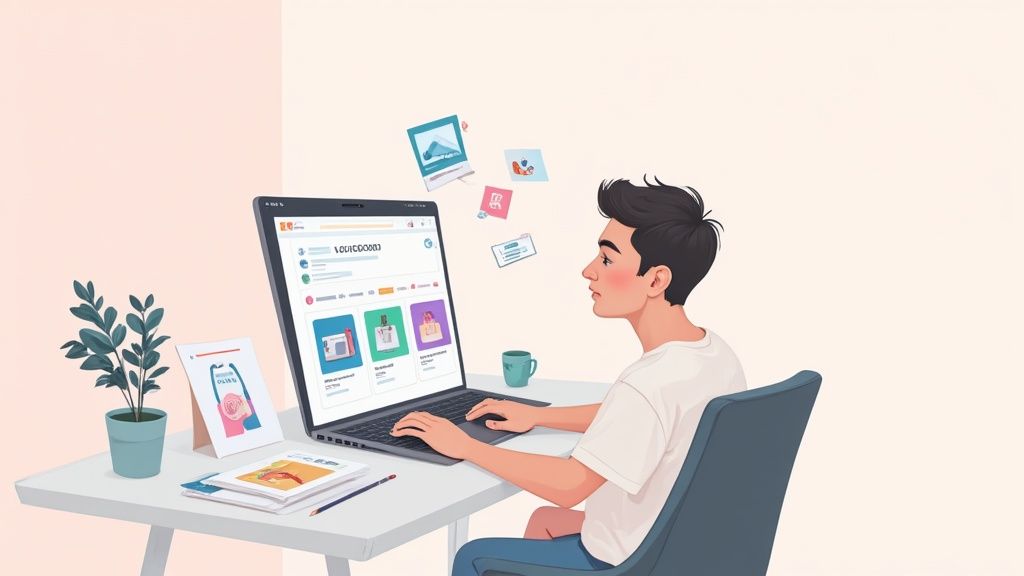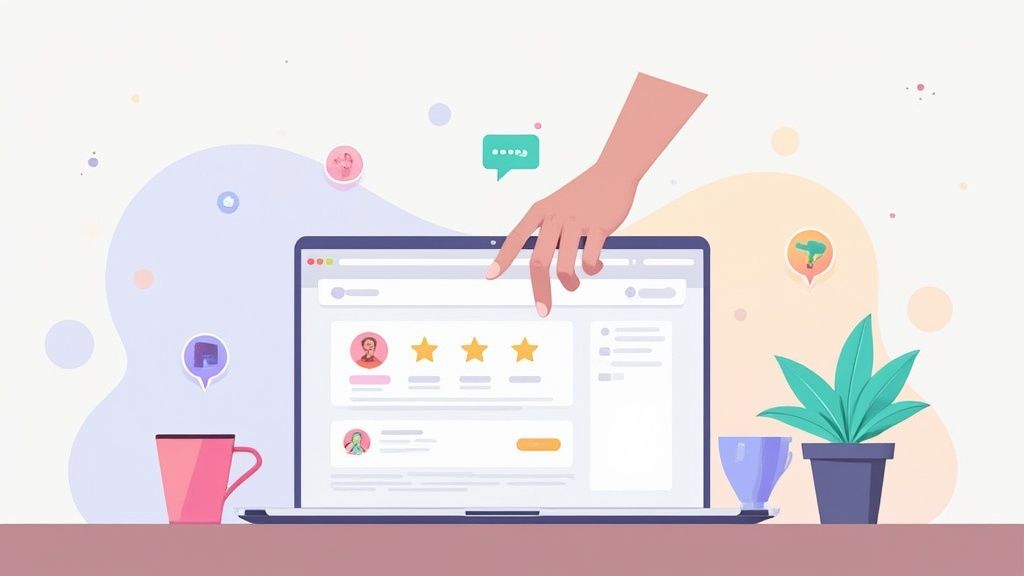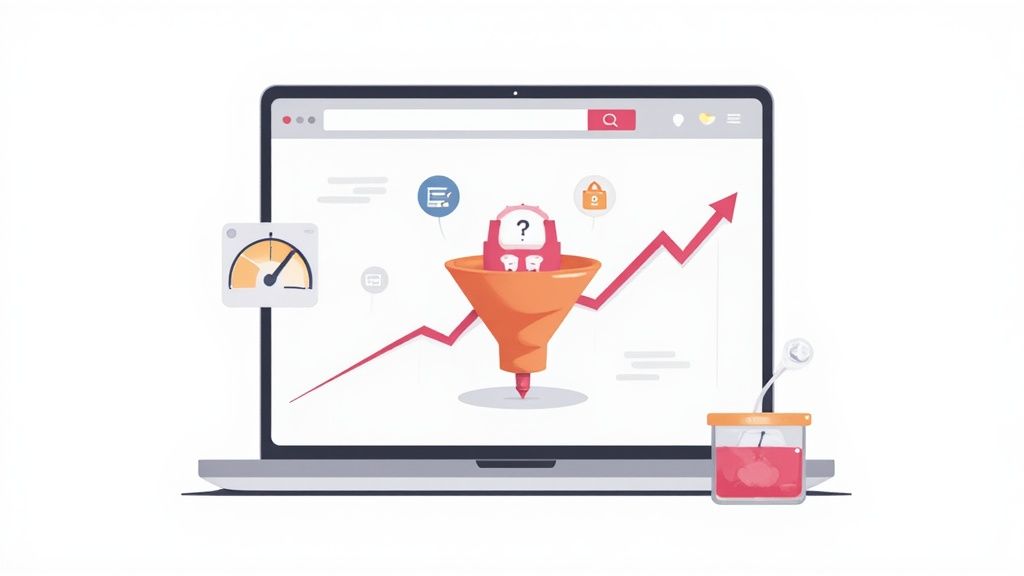
E-commerce customer retention is all about getting the customers you already have to come back and buy again. It’s a shift in mindset—instead of just chasing new leads, you focus on turning those one-time buyers into genuine, loyal fans.
The core idea is simple but powerful: your most valuable asset is the customer base you’ve already built.
Why Customer Retention Is Your Real Growth Engine
Let's be honest, the endless and expensive chase for new customers is exhausting. The real engine for sustainable growth in e-commerce isn't just acquisition—it's loyalty.
In a market where customer acquisition costs are always climbing, doubling down on your existing shoppers is the single most powerful move you can make. This isn't just about saving a few bucks; it’s about fundamentally changing your business's financial future for the better.
The Financial Power of Loyalty
The numbers don't lie. Improving your customer retention by just 5% can boost profits anywhere from 25% to a staggering 95%.
How is that even possible? It’s because returning customers tend to spend more over time and are often less costly to serve. When you consider that acquiring a new customer can be up to five times more expensive than keeping an existing one, every dollar you invest in retention delivers a much, much higher return. If you want to dive deeper into the data, Exploding Topics has some great retention statistics.
This visual from Shopify really drives the point home, showing how different strategies all work together to create a retention-focused business.
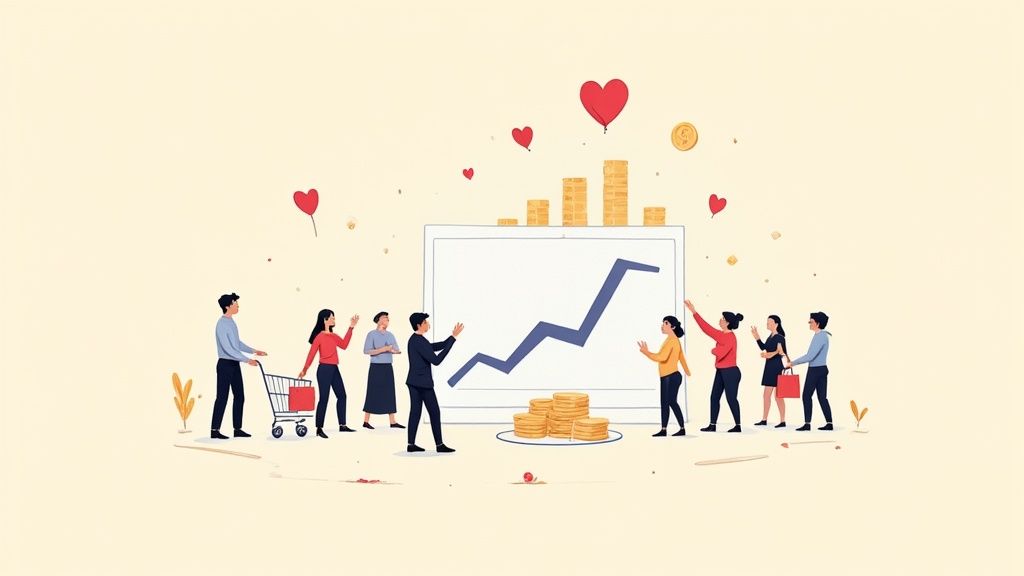
The big takeaway here is that retention isn't a one-and-done action. It’s the result of stringing together multiple positive experiences, from a killer loyalty program to top-notch customer service and personalized emails that actually feel personal.
Shifting from Transactional to Relational
Modern e-commerce success is built on relationships, not just one-off transactions. That first purchase isn't the end of the road; it's the beginning of a conversation.
Your goal should be to make every single interaction so positive and valuable that the thought of buying from a competitor feels like a major downgrade. This guide will take you beyond the basics, giving you actionable strategies to build that kind of unbreakable bond.
We're going to get into how you can create that loyalty through:
- Exceptional Post-Purchase Care: Turning the moments after a sale into a memorable experience that builds excitement and trust.
- Genuine Personalization: Using data to make customers feel seen and understood, offering them exactly what they need, right when they need it.
- Smart Rewards and Incentives: Designing loyalty programs that offer real value beyond just discounts, creating a sense of community and exclusivity.
By focusing on the customers you already have, you're not just increasing sales; you're building a resilient brand with a loyal following that acts as its own marketing force. This is the foundation of long-term, profitable growth in any e-commerce venture.
Crafting a Post-Purchase Experience That Builds Fans

The moment a customer clicks "buy" isn't the finish line—it's the starting gun. This is where the real work of e commerce customer retention begins. The post-purchase experience is your single greatest opportunity to transform a simple transaction into a memorable event that builds genuine fans.
Unfortunately, many brands treat this phase as a purely logistical afterthought. They send a generic order confirmation, a tracking number, and then go silent until it’s time to ask for another sale. This silence creates a vacuum of uncertainty and anxiety for the customer, which is the exact opposite of what you want.
Your goal is to fill that space with communication, excitement, and reassurance. It's about showing the customer you care just as much about their experience after you have their money as you did before.
From Confirmation to Celebration
Think of your order confirmation email as the first chapter of your brand's story with that customer. Instead of a bland, text-only receipt, turn it into a celebration of their purchase.
This is your chance to reinforce their decision and build anticipation. For example, a skincare brand could include a quick tip on how to incorporate the new product into their routine. A clothing company might add a link to a style guide showing different ways to wear the item they just bought.
The key elements of a great confirmation email include:
- A warm, personal tone that reflects your brand’s personality.
- Clear order details with images of the products they purchased.
- An estimated delivery window to manage expectations from the very beginning.
- A link to your support or FAQ page to make getting help easy.
Proactive Shipping Updates That Eliminate Anxiety
Waiting for a package can be stressful. Did my order go through? When will it ship? Where is it now? Proactive communication is the antidote to this "buyer's remorse" anxiety. Don’t wait for your customers to ask for an update; give it to them before they even think to look.
Set up automated alerts for key milestones in the shipping journey. This isn’t just about sending a tracking number. It's about narrating the journey of their package.
The most effective post-purchase communication feels less like a series of transactional updates and more like a helpful guide ushering a customer’s purchase safely to their door. This simple shift in perspective can dramatically improve customer satisfaction and trust.
A good sequence of shipping updates might look like this:
- "Your Order is Confirmed!": Sent immediately after purchase.
- "Good News! Your Order Has Shipped!": Includes the tracking number and a link.
- "Heads Up! Your Package is Out for Delivery!": Builds excitement for its arrival.
- "It's Arrived! Your Order Has Been Delivered!": Confirms receipt and opens the door for follow-up.
The Unboxing Moment and Beyond
The unboxing experience is where the digital meets the physical. It’s a sensory experience that can create a powerful, lasting impression. This doesn’t mean you need to spend a fortune on custom boxes (though branded packaging helps).
Simple, thoughtful touches can make a huge impact. A handwritten thank-you note, a small free sample of a related product, or even just beautifully arranged tissue paper can elevate the experience from mundane to magical. For example, a coffee subscription box might include a small bag of a new blend as a surprise.
This moment is also the perfect time to guide the customer on what to do next. Include a small card that encourages them to leave a review, share their unboxing on social media with a specific hashtag, or provides a special discount code for their next purchase.
Turning Returns into a Retention Opportunity
No one likes dealing with returns, but they are an unavoidable part of e-commerce. How you handle them can either destroy customer trust or solidify it for life. A confusing, difficult, or costly returns process is a guaranteed way to lose a customer forever.
Make your return policy clear, simple, and easy to find. Better yet, offer a self-service returns portal where customers can initiate the process and print a shipping label without needing to contact support. This empowers the customer and reduces the workload for your team.
Handling these interactions gracefully is critical. For seamless support that can significantly improve customer satisfaction and build lasting relationships, consider the benefits of outsourcing ecommerce customer support. A positive return experience—where the customer feels heard and respected—proves that you stand behind your products and value their satisfaction over a single sale. That kind of trust is invaluable for long-term e commerce customer retention.
Using Personalization to Stay Top of Mind
If your marketing feels generic, you're invisible. It's as simple as that. In today's crowded market, personalization isn't just a nice-to-have; it's the most powerful way to cut through the noise and make every customer feel like they're your only customer. This is the bedrock of strong e commerce customer retention.
This goes way beyond just dropping a {{first_name}} tag into an email subject line. Real personalization means digging into customer data—their browsing history, past purchases, even abandoned carts—to create experiences that feel genuinely helpful and uniquely relevant.
When you nail it, it feels like magic to the customer. You’re not just another brand shouting for their attention; you become a trusted partner that actually gets them.
Segmenting for Smarter Communication
The whole game starts with smart audience segmentation. Instead of blasting the same message to everyone on your list, you create smaller, more focused groups based on what they've actually done. This is how you stop broadcasting and start having real conversations.
Consider breaking down your audience with these powerful strategies:
- Purchase History: Group customers by what they've bought. Someone who buys running shoes has totally different needs than someone who buys yoga mats. Talk to them accordingly.
- Browsing Behavior: Did someone look at your new line of coffee mugs three times but never bought one? That’s a segment. A gentle nudge with a "Still thinking it over?" email can work wonders.
- Purchase Frequency: Your VIPs who buy every month deserve a different kind of conversation than your one-time shoppers or those at risk of churning. Treat each group differently to bring them back.
- Customer Lifetime Value (CLV): Identify your highest-value customers and roll out the red carpet. Give them exclusive offers, early access, and special recognition. They've earned it.
A brand selling specialty coffee could send an automated reorder reminder to a customer who buys the same dark roast every month. At the same time, they could send a guide on new brewing techniques to a more adventurous shopper who tries a different blend each time. It's about relevance.
This chart really drives home how targeted, personalized campaigns move the needle on key retention metrics.
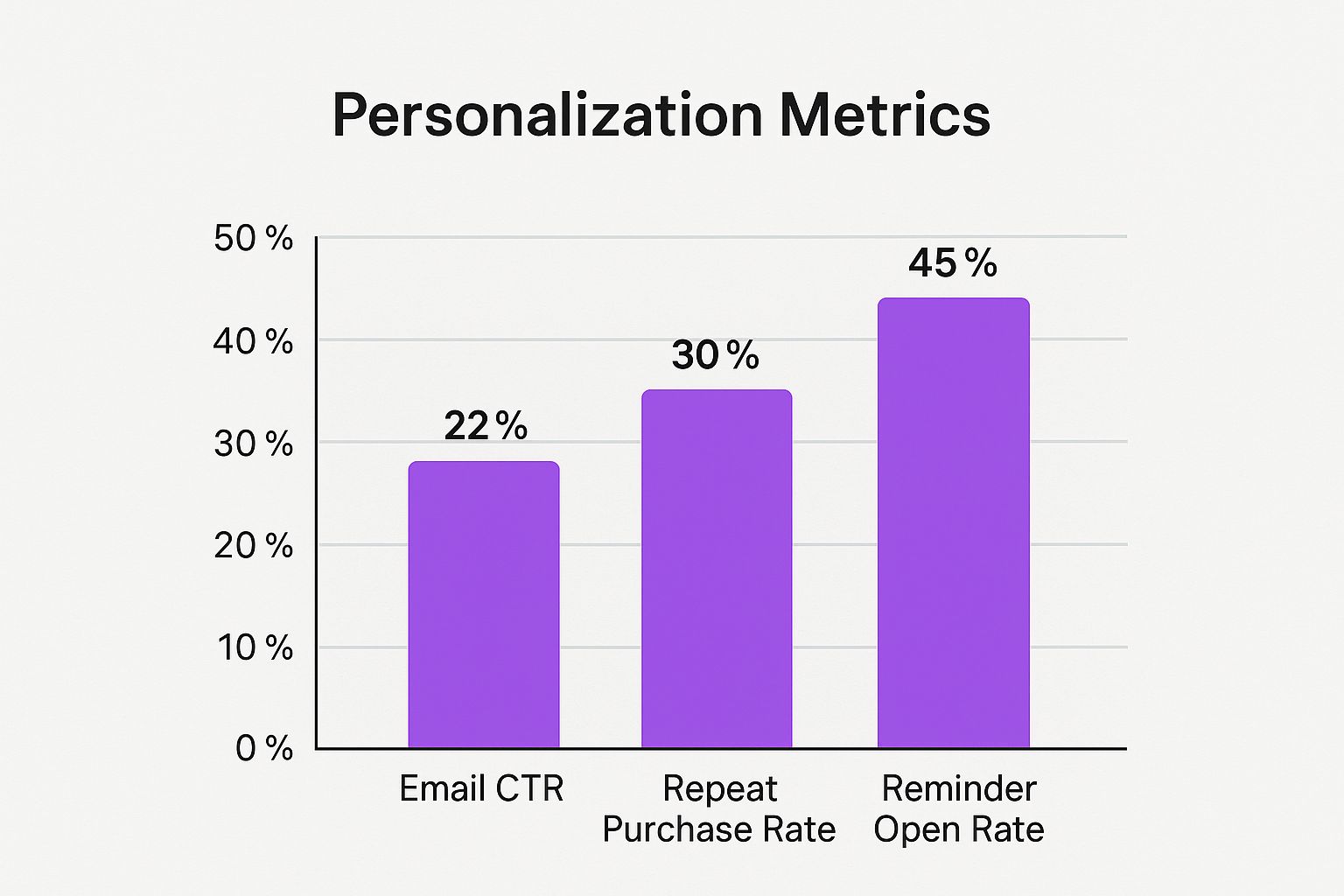
The data doesn't lie. The more relevant the message, the higher the engagement—and that leads directly to more repeat business.
Using Data for Hyper-Relevant Experiences
Once your segments are in place, you can use that data to create marketing touches that feel less like ads and more like helpful recommendations from a friend. This is where automation and data analysis really shine.
For example, think about automated email flows triggered by specific actions. If a customer buys a printer, you could automatically send them an email a few months later with a discount on ink cartridges—right when they’re probably running low. This predictive timing is a huge driver of repeat purchases.
This has become even more important with the explosion of mobile shopping. With mobile devices now accounting for nearly 80% of all retail website visits, retaining customers depends on creating a seamless experience on their phones. Convenience features like easy returns and fast delivery are no longer optional.
The goal of personalization isn't to be clever; it's to be useful. When you use data to solve a customer's problem or anticipate a need, you're not just selling a product—you're building trust and cementing loyalty.
Putting Personalization into Practice
Look, creating these kinds of tailored experiences doesn't have to be a massive, complex undertaking from day one. Start with a few high-impact tactics and build from there.
- Smarter Product Recommendations: Use a customer's browsing and purchase history to suggest products they'll actually love. Don't just show them best-sellers. Feature these on your homepage, in email newsletters, and on product pages with a "You might also like" section.
- Replenishment Reminders: This is a no-brainer for consumables like supplements, skincare, or coffee. Set up automated reminders that prompt customers to reorder just before they run out. It's a simple service that can dramatically boost your repeat purchase rate.
- Behavior-Triggered Emails: An abandoned cart shouldn't be the end of the story. Send a follow-up email a few hours later reminding them what they left behind. You can also trigger emails for "browse abandonment"—when someone views a product multiple times without ever adding it to their cart.
These strategies shift your marketing from a generic monologue into a personal dialogue, making customers feel seen and valued. For those ready to dive even deeper, we have a complete guide exploring some incredible real-world examples of AI personalization in ecommerce.
Designing Loyalty Programs That Actually Work
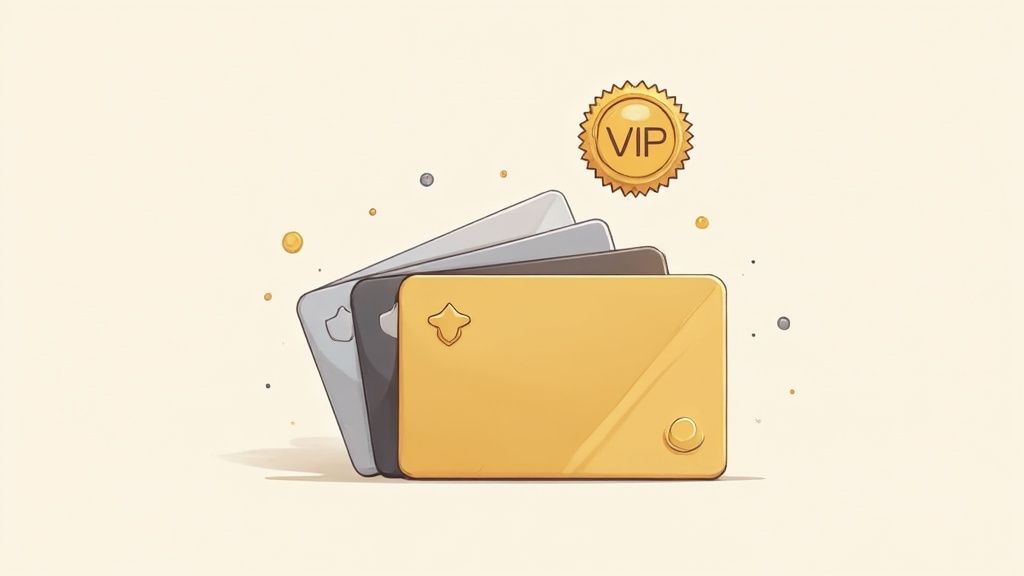
Let's be honest. Most loyalty programs are just glorified discount cards. Customers sign up, maybe use a coupon once, and then completely forget about it. They're transactional, a little boring, and do next to nothing for genuine e commerce customer retention.
To build a program that people actually care about, you need a mental shift. Stop rewarding transactions and start rewarding true loyalty. A great program makes your best customers feel seen, appreciated, and part of an inner circle. It's about creating a sense of belonging that a simple price cut can't buy.
The goal here isn't just to build a list of members waiting for the next sale. It's to build a community.
Moving Beyond Simple Points and Discounts
The classic "spend-and-get" points system is everywhere, but it's also the easiest for customers to ignore. While it's simple to understand, it rarely creates any kind of emotional connection to your brand. To make your program stand out, you have to pack it with value that money can't always buy.
Put yourself in your best customer's shoes. What do they really want? Is it status? Convenience? The inside scoop? Use those desires as the building blocks for your rewards.
Here are a few ways to add that kind of meaningful value:
- Early Access to New Products: This is a huge one. Letting loyal members shop new collections before anyone else creates a powerful feeling of exclusivity.
- Exclusive Content: Offer members-only access to tutorials, behind-the-scenes videos, or in-depth guides related to your products. A beauty brand, for example, could create advanced makeup tutorials just for its top-tier members.
- Private Community Access: Start a members-only Slack channel, Discord server, or private Facebook group. This is where they can connect with each other and your team, fostering a real sense of community.
- Non-Monetary Rewards: Think outside the discount box. Things like free shipping upgrades, priority customer support, or even a surprise birthday gift can have a massive impact on how a customer feels about your brand.
By layering these kinds of experiential rewards into your program, you create something people genuinely want to be a part of. It stops being about saving a few bucks and starts being about the elevated experience of being a loyal customer.
Choosing the Right Loyalty Program Model
Not every loyalty program is built the same, and what works for a subscription coffee brand will fall flat for a luxury fashion house. The first step is figuring out which structure actually fits your business and, more importantly, your customers.
Let's walk through the most common models to see which one might be the right fit for you. Each one has its own vibe and is suited for different business goals.
Comparison of E-Commerce Loyalty Program Models
Choosing the right framework for your loyalty program is a critical decision. This table breaks down the four most common models, looking at how they work, who they're best for, and what potential issues you should watch out for.
Ultimately, the model you choose should feel like a natural extension of your brand's personality and the relationship you have with your customers.
The most effective loyalty programs are a direct reflection of the brand's core identity. Sephora’s Beauty Insider program works because it offers tiered access to exclusive products and events, perfectly aligning with its customers' passion for beauty and discovery.
Measuring the Success of Your Program
Launching a loyalty program without a clear way to measure its impact is like flying blind. You have to track specific metrics to make sure the program is actually working—delivering value to your customers and boosting your bottom line.
Your main goal is simple: prove that members of your program are more valuable than non-members.
Here are the key numbers you need to be watching:
- Repeat Purchase Rate: This is the big one. Are your loyalty program members coming back to buy more often than everyone else? A healthy program will show a significant lift here.
- Average Order Value (AOV): Do members spend more per transaction? Tiered programs are especially good at nudging customers to add a little more to their cart to reach that next level of rewards.
- Customer Lifetime Value (CLV): This is the ultimate measure of success. Over time, your loyalty program members should have a clearly higher CLV than the rest of your customers. This is the proof that your retention efforts are paying off long-term.
- Redemption Rate: This metric shows you how many of the points or rewards you're giving out are actually being used. If the rate is low, it's a red flag that your rewards aren't compelling enough or the redemption process is too confusing.
By keeping a close eye on these numbers, you can constantly tweak and improve your program. Test out new rewards, adjust your tiers, and make sure it remains a powerful engine for e commerce customer retention and sustainable growth.
Tracking the Retention Metrics That Matter
You can't improve what you don't measure. Gut feelings and guesswork just won't cut it when you're trying to build a business that lasts. If you really want to understand the impact of your efforts on e-commerce customer retention, you have to get comfortable with the data.
This means looking past the flashy, surface-level numbers like site traffic and one-off conversions. We need to dig into the metrics that truly reveal the health of your customer relationships and, more importantly, predict your future revenue. Tracking the right data is how you spot problems before they blow up, identify who your real VIP customers are, and uncover growth opportunities you never knew existed.
Don't worry, you don't need to become a data scientist overnight. It’s really about getting a handle on a few core concepts that tell the real story of your brand's health.
Unpacking Customer Lifetime Value (CLV)
If you only track one retention metric, make it this one. Customer Lifetime Value, or CLV, represents the total amount of money you can expect a customer to spend with your business over their entire relationship with you. It’s a powerful, forward-looking number that pulls your focus from short-term sales to long-term value.
A simple way to get a baseline for your CLV is:
(Average Order Value) x (Average Purchase Frequency) x (Average Customer Lifespan)
Knowing your CLV is a game-changer for making smarter decisions on marketing spend. For instance, if you discover the average customer is worth $500 over their lifetime, spending $50 to acquire them suddenly looks like a brilliant investment. It completely reframes your acquisition costs in the context of long-term profitability, not just a single sale.
Measuring Repeat Purchase Rate
While CLV gives you the big-picture forecast, your Repeat Purchase Rate (RPR) tells you how you're doing right now. It's a direct measure of how effective you are at getting that crucial second, third, and fourth sale.
Basically, it's a measure of your brand's "stickiness." A high RPR means your products and the overall experience are compelling enough to bring people back for more.
The formula couldn't be simpler:
RPR = (Number of Customers Who Purchased More Than Once) / (Total Number of Customers)
This metric is a direct reflection of your retention strategy. If you launch a new loyalty program or dial in your post-purchase email flow, you should see a tangible lift in your RPR. For context, an average RPR for e-commerce hovers around 30-40%, but this can vary wildly by industry.
Tracking your Repeat Purchase Rate is like taking your business's pulse. A steady or rising rate indicates a healthy, growing relationship with your customers. A declining rate is an early warning sign that something needs to be fixed—fast.
Calculating Your Customer Churn Rate
On the flip side of retention, you've got churn. Your Customer Churn Rate is the percentage of customers who stop buying from you over a specific period. It’s the metric that tells you, in no uncertain terms, how many customers you're losing.
Here’s how you calculate it:
Churn Rate = (Lost Customers at End of Period) / (Total Customers at Start of Period)
High churn can be a silent killer for any business. It locks you into an expensive, never-ending cycle of acquiring new customers just to tread water. By keeping a close eye on your churn rate, you can see if your retention efforts are actually moving the needle. If your churn rate drops after you implement a new personalization strategy, you know you're onto something.
This screenshot from Klaviyo shows how these key metrics often pop up on an analytics dashboard, giving you a clear, at-a-glance view of your store's health.
Seeing your data in a dashboard format makes it so much easier to spot trends over time. You start to connect the dots between the actions you take and how your customers behave. For a deeper dive, check out our full guide to the most important customer retention metrics for e-commerce brands.
Putting It All Together with the Right Tools
The good news is that you don't have to track these numbers with a manual spreadsheet. Most modern e-commerce platforms and marketing tools have built-in analytics that do the heavy lifting.
- Shopify Analytics: Straight out of the box, Shopify's backend offers solid reporting on returning customer rates, AOV, and a whole lot more.
- Klaviyo or Mailchimp: Tools like Klaviyo or Mailchimp are fantastic for tracking email engagement and can even calculate CLV based on purchasing behavior tied to your campaigns.
- Google Analytics 4 (GA4): For a seriously deep dive, GA4 gives you powerful insights into user behavior, helping you map out the customer journey between purchases.
Beyond these core retention rates, a deeper understanding of measuring marketing campaign effectiveness can reveal which of your strategies are truly building loyalty. The key is to set your benchmarks, track these metrics consistently, and let the data guide every single retention strategy you deploy.
Answering Your Top E-Commerce Retention Questions
As you start shifting your focus from pure acquisition to building real customer loyalty, a lot of questions are bound to come up. It's a different way of thinking, with its own set of challenges and metrics. Let's tackle some of the most common questions we hear from brands getting serious about retention.
Our aim here is to give you straight, practical answers to help you navigate this important shift in strategy. We'll cover everything from what "good" actually looks like to making a case for the tools you'll need along the way.
What Is a Good Retention Rate?
This is always the first question, and the honest-to-goodness answer is: it really depends. You'll see industry reports throwing around an average e-commerce customer retention rate between 31% and 38%. But that number is almost meaningless without context.
What you sell completely changes the game.
- Consumables: If you're selling things like coffee, skincare, or vitamins, your customers should be coming back regularly. A higher rate is expected and necessary.
- High-Ticket Items: On the other hand, a store selling mattresses or custom furniture will naturally have a much lower rate. People just don't buy those things often.
Instead of getting hung up on a generic industry number, start by figuring out your own baseline. What's your retention rate right now? Your real goal should be to see that number tick up, month over month. As long as the trend is positive, you're winning.
The only benchmark that truly matters isn't some industry average; it's your own past performance. Beating your numbers from last quarter is a far more powerful indicator of success than chasing an arbitrary external goal.
When Should I Invest in Retention Software?
You don't need a massive, expensive tech stack on day one. In fact, you shouldn't. Most e-commerce platforms like Shopify have built-in analytics that can give you basic but crucial numbers like repeat purchase rate. Start there.
The time to invest in a dedicated tool is when you hit a specific wall that your current setup just can't break through.
- Struggling with personalization? This is when an email and SMS platform like Klaviyo becomes a game-changer, letting you automate campaigns based on actual customer behavior.
- Want to build a real community? A specialized loyalty program tool like Yotpo can give you the framework for a compelling points or tiered system.
- Drowning in customer emails? A help desk solution can organize the chaos and turn your post-purchase support into a retention engine.
The key is to let the strategy lead the technology. Figure out what you want to accomplish first, then find the tool that helps you do it efficiently. Don't buy the software and then try to invent a problem for it to solve.
How Do I Prove the Value of Retention Efforts?
To get buy-in from your team, your boss, or your investors, you have to speak their language. That language is always data. Proving the ROI of your retention work means drawing a straight line from your actions to the financial metrics that matter.
Zero in on these three areas for your reporting:
- Increased Customer Lifetime Value (CLV): Show how the average CLV for members of your loyalty program is 2x, 3x, or even 5x higher than for non-members.
- Higher Repeat Purchase Rate: Track this metric before and after launching something new. Did it jump after you rolled out a new post-purchase email flow? Show the numbers.
- Lowered Customer Acquisition Cost (CAC): This one is powerful. As you get better at keeping customers, you become less reliant on expensive, top-of-funnel ads. Frame it as improving overall marketing efficiency and profitability.
Present your wins with clear, undeniable data. A statement like, "After implementing our replenishment reminders, the repeat purchase rate for our skincare line increased by 15% in Q3," is impossible to argue with. Concrete data makes the value of your work crystal clear.
At ECORN, we specialize in turning these strategies into reality for growing Shopify brands. We help businesses optimize their stores for conversion and build the systems needed for powerful, long-term customer retention. Explore our flexible subscription packages to see how we can help you scale.






